How 'Star Trek' Changed Visual Effects History
From miniatures and glitter to cutting edge computer graphics, the franchise has led the way
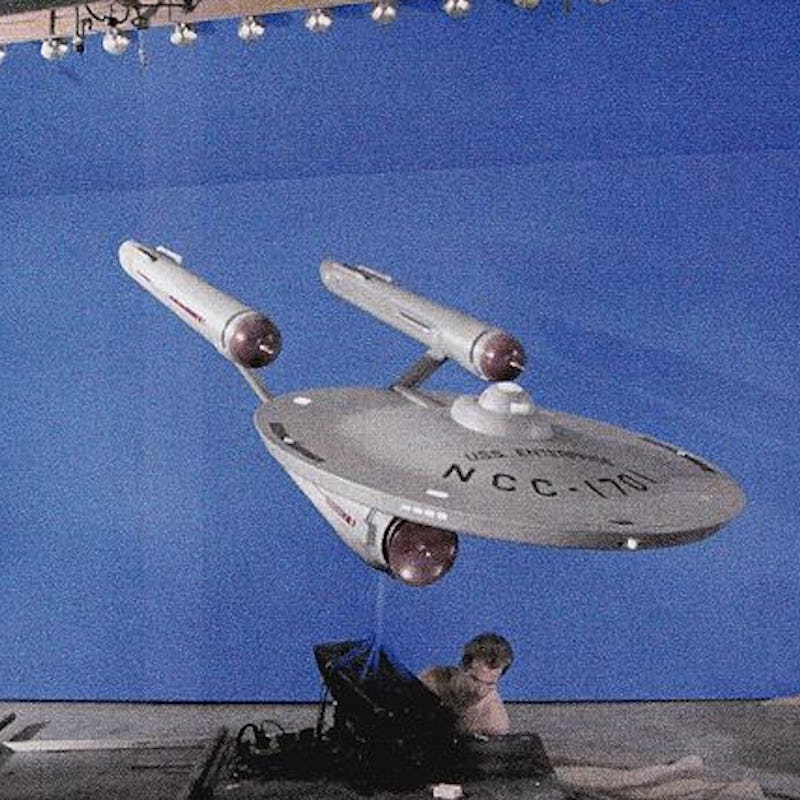
The Star Trek TV and film series haven’t just been a journey through the history the voyages of the Starship Enterprise; they’ve also served as a showcase for cutting edge and innovative visual effects techniques. From models and miniatures used in the TV series, to some of the earliest computer graphics seen on film in Wrath of Khan , and to new ways of achieving complex effects on screen, including in this weekend’s Star Trek: Beyond , Inverse takes a look at the biggest VFX innovations in Trek history.
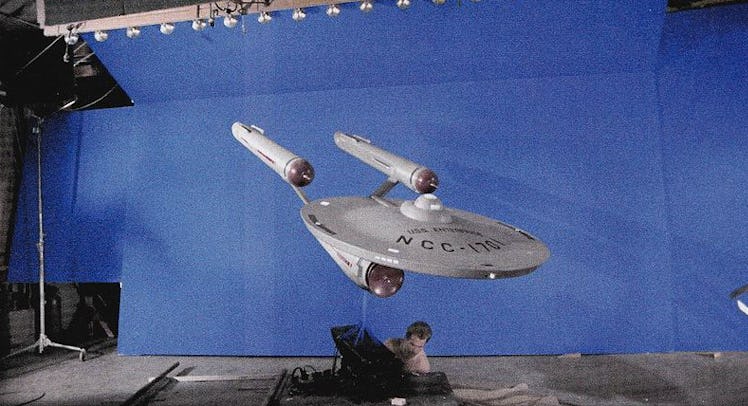
The original USS Enterprise miniature set up for filming.

Models and Glitter
In the mid-1960s, special effects in films and TV were the domain of miniatures, matte paintings on glass and optical compositing – all on real film. The effects in Star Trek: The Original Series were no different, but the sheer number of shots made for the show, and the need for them to be of “film quality,” required some neat innovation.
The Howard Anderson Company was the original effects studio behind this work, with its most well-known contribution being the build of the miniature USS Enterprise. The ship was actually realized as two different sized scale models, and then would be combined with starfield backdrops and planet paintings.
Howard Anderson also devised an effect that would pervade the Trek series for years to come: the transporter, in which crew members were beamed from ship to planet or just about anywhere else. The futuristic effect was achieved in a surprisingly low-tech way for the Original Series, with aluminum powder and old-school optical compositing.

Here’s how it worked: First the person or persons being transported were filmed standing in position. Then they stepped out of frame while the camera captured an empty set. What was then needed was a “mask” of the figures being beamed — essentially an outline of them. A further element required was the glittering or beam effect (this is where the aluminum powder came in). It was photographed separately by dropping the powder from above and lighting it with an intensive light against a black background.
When the original piece of film was combined with the mask (which is like a hole in the piece of film) and the glitter element, the glitter effect showed up only over the outline of the figures. The image of the figures from the original piece of film was faded out, or in, to finally reveal the materialization/dematerialization effect, and this was all achieved with film cameras and optical printing.
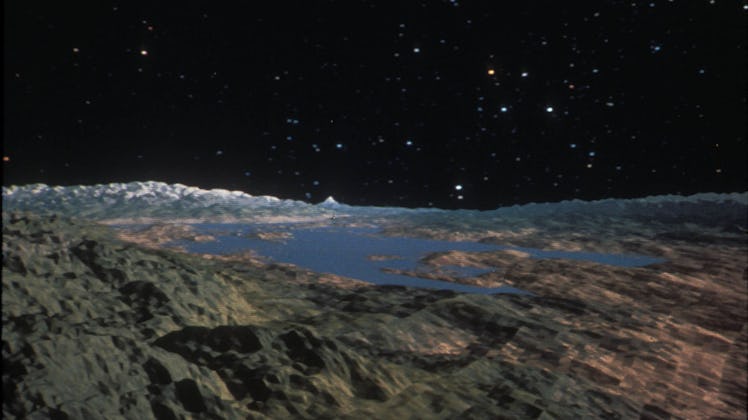
A scene from the Genesis Sequence in Wrath of Khan, a breakthrough effort made by the Lucasfilm Computer Division in collaboration with ILM.
The Pixar Connection
An early Trek film boasts a sequence that is one of the most significant in digital visual effects and computer graphics lore. The terraforming planet sequence, known as the Genesis Demo, in Star Trek II: Wrath of Khan holds the reputation as the first major use of computer graphics in a feature film.
It was created by the Lucasfilm Computer Division, a separate part of Lucasfilm that George Lucas had established to research various digital editing and computer graphics applications. It worked alongside the main Lucasfilm effects outfit Industrial Light & Magic, and ultimately — and famously ‚ would become Pixar.
But before Toy Story , there was this Genesis sequence, containing the kind of CG never before seen on film. This was a big deal. Very few films before Wrath of Khan had made use of computer graphics at all for effects work, and none to this level of complexity. Usually only miniatures ensure enough fidelity and creativity for an effects shot.
Alvy Ray Smith, who conceived and directed the Genesis sequence, told Inverse that although it was a “first,” his team was “very confident” they could pull it off. “Not that we were justified in that confidence, but that seems to be the nature of youth,” he adds. “Of course we could do it! But to be fair, I did design the piece to play to our particular strengths at the time.”
Those strengths were in utilizing fractals, particle systems, texture mapping, bump mapping, digital painting and a moving camera (aimed at mimicking a typical planetary flyby that had become popular then on television). They were all computer graphics techniques in their early days, but the project had the benefit of having some of the brightest minds at Lucasfilm on the job.
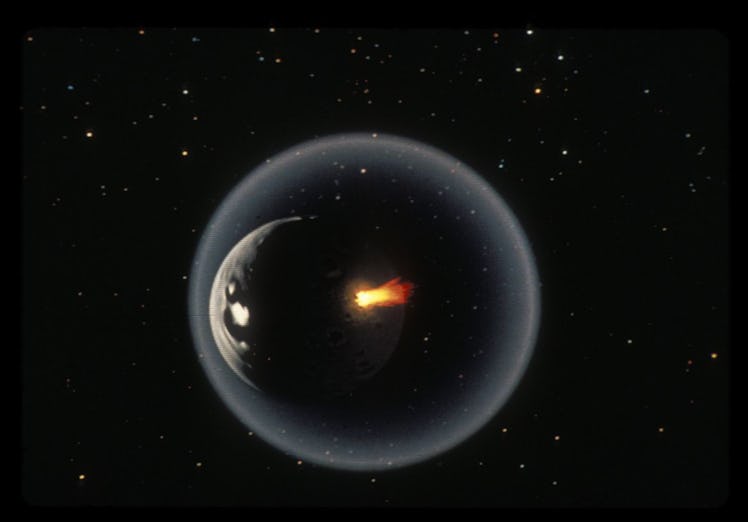
The shot produced was more than a minute long in one continuous camera move over the planet.
The Genesis Demo became a 67-second long shot showing a torpedo hitting the planet, exploding, causing a shockwave and then showing geological and Earth-like structures appearing. It would be rendered on VAX computers (remember, this is 1982), with some frames taking just five minutes to produce while others required five hours.
Smith says the sequence was “the first use of computer graphics in a successful motion picture” and that he is still incredibly proud of the work. He notes that if you watch closely, there’s a section where the spacecraft hit the fractal mountains on one frame, owing to the random heights. So one artist, Loren Carpenter, who was behind the fractal graphics, went into the database of imagery, by hand, and “found the offending frame and carved a notch in the mountain at the right place for that one frame. If you watch for that frame, it’s rather obvious and gets a guaranteed chuckle out of an audience who has been told about the fix beforehand.”
How VFX on television changed forever

Fluorescent orange screens were one of the key advances made on Star Trek: The Next Generation.
Before the late 1980s and early 1990s, most episodic television shows were still shot on film, and any effects were mainly done with miniatures; optical compositing was also done on film. Star Trek: The Next Generation (TNG), which began airing in 1987, changed everything. TNG was still shot on film, but the footage was then transferred to video tape. As the series continued, digital tape formats also began to be used. This process enabled a new wave of video-based visual effects to be employed.
Why was this a big deal? Speed. Having footage on video meant things could happen faster with editing and adding effects. It was a hugely necessary step, since in TNG ’s first three seasons, each episode would require about 60 to 70 VFX shots, a significant amount back then. And while TNG was still being made, the Star Trek: Deep Space Nine (DS9) series also entered production, requiring a further ramp up of visual effects.
Eric Alba was a visual effects associate on last two seasons of TNG , two seasons of DS9 and one season of Star Trek: Voyager , and contributed to the film Star Trek: Generations . Which means he was there during all of this transition in the TV and film effects world, and says that it “forever influenced the way VFX were made for television.”
But that doesn’t mean all of TNG ’s visual effects were only done with video systems. Indeed, spacecraft models were still physically built and filmed as they had been done for decades. However, TNG would advance the art of motion control photography. One development was in the form of using UV black lights on fluorescent orange screens (instead of blue screens) for ship matte passes. “Before that,” explains Alba, “people would use 8 by 4 foam core boards, for contrast, around the ship in multiple passes to do silhouette — white on black — passes, which never worked because the cards would kick light and spill on the ship model.”
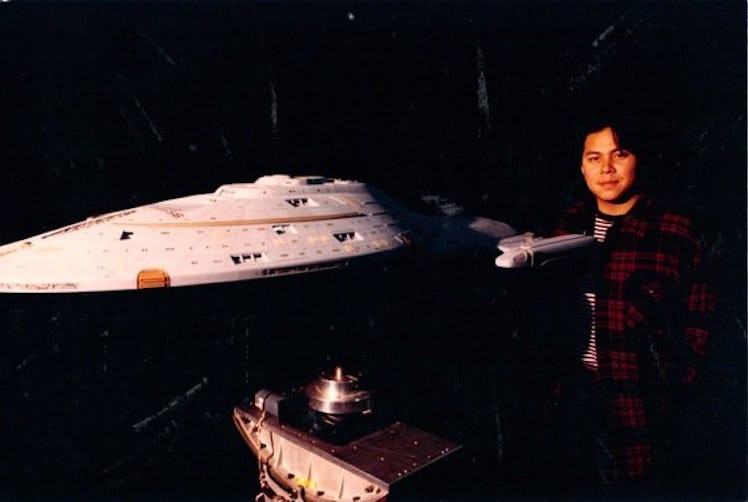
Visual effects associate Eric Alba poses with a spaceship model from Star Trek: Voyager.
There would also be a move during the making of TNG and DS9 to incorporate fully CG versions of the spacecraft and other elements that would normally have been done by miniatures. Although other shows like Babylon 5 and DSV had also pioneered digital effects for television, it was these Star Trek series that perhaps gave CG on TV its greatest exposure.
Another important development that might not sound as glamorous but that Alba highlights as being a crucial advancement was the adoption of digital disk recorders (DDR) on TNG . “These were 30-second disk buffers of our transferred film footage that allowed us to ping-pong layers of elements on top of each other with no degradation. We could layer hundreds with no worry of compromising fidelity or quality of a final composited shot. Yikes, that was ambitious!,” Alba confesses.
I think TNG is a seminal series,” adds Alba, “if only because they had to create a capture, shoot and post approach that was fast, modular, scalable and executable in a two to three week production schedule. Considering that they had to produce 26 episodes a year is a large task. And then when DS9 became a second show in parallel production we now had to produce 52 hours of television a year in the same window of air dates.”
J.J. Abrams’s Star Trek Re-imagined Lens Flares
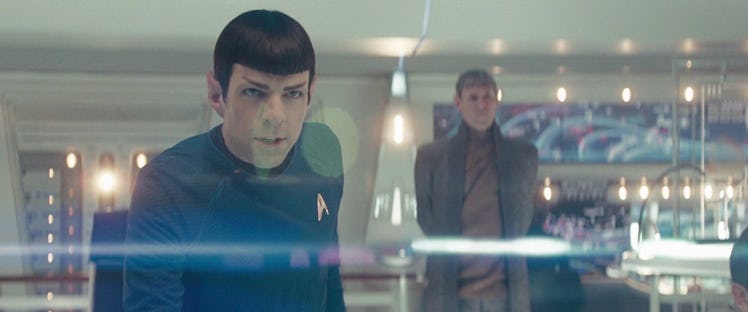
Lens flares, a trademark of J.J. Abrams’ Star Trek, were achieved both in-camera and with the help of visual effects
Much has been made of J.J. Abrams’s use of lens flares in his first Star Trek film. It’s fair to say they are dominant in many scenes, when the Enterprise passes in front of a sun or star, for example, or when the ship’s lights are visible as it whizzes past camera, or even on the bridge of the Enterprise as crew members move about. But they are not without motivation; Abrams’ intention was always to suggest that this is way light and camera lenses behave in the real world.
So real, in fact, that many flares seen in the film were simply the ones captured on set (albeit occasionally achieved with flashlights shining into the lens operated from near off-camera). They were enhanced by the use of anamorphic lenses which “squeeze” the film frame and provide a particular look to the final image.
Of course, many of Star Trek ’s scenes were not capable of being shot for real — they were digital creations by Industrial Light & Magic, which had to replicate the live action look of lens flare aberrations to Abrams’s taste. In doing so, compositors at the visual effects studio analyzed the way light flared in anamorphic lenses and replicated that in digital form, even creating a tool called SunSpot to achieve it.
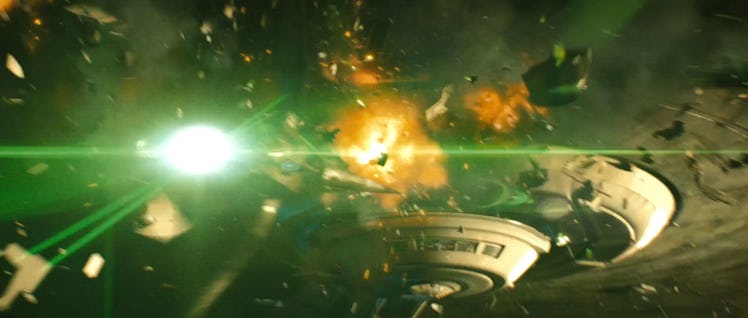
ILM sequence supervisor Todd Vaziri was one of the artists behind the lens flare work, and Millimeter Magazine at the time reported on his work on the SunSpot system, explaining that it “essentially combines off-the-shelf software, certain proprietary ILM tools, photographed elements, and several custom paint elements to painstakingly match the flares captured on the negative.”
In visual effects terms, the lens flares were perhaps not technically revolutionary but served a key part of the storytelling – always a goal by VFX artists. Vaziri himself suggests on his website, FXRant, that the “flares give the film a unique flavor of spontaneity and intensity, paradoxically giving the film a documentary-style grittiness, as well as a fanciful, otherworldly, abstract quality.”
A New Chance to Show Off Old Favorites
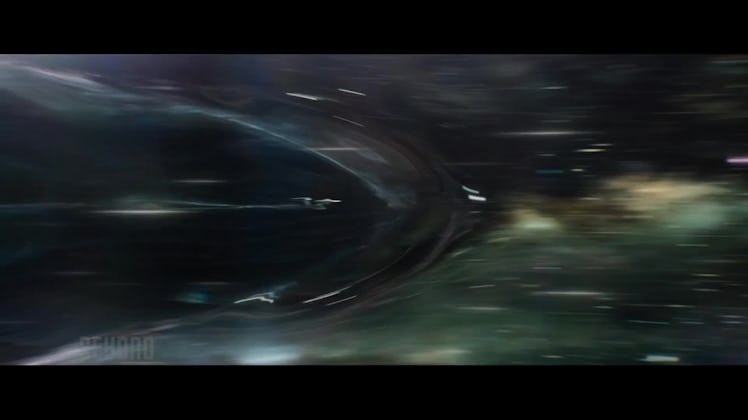
If there’s one kind of visual effect that has evolved with the Trek TV and film franchise, it’s warp speed. Advances in design, computer graphics and compositing techniques have allowed warp speed to become a more visceral, immersive, and impressive visual effect over the years.
In the latest incarnation, Justin Lin’s Star Trek: Beyond , the warp speed effect evolved even further when the film’s visual effects supervisor Peter Chiang suggested the idea of showcasing a more scientific approach.
“Right from the outset I kind of presented the idea of folding space and gravitational lensing,” he told HD Video Pro. Previous warp speeds had been a streak-type look, he notes, but this time it was developed as a folding space effect with a ‘warp bubble’ appearance. Luckily, the visual effects studio behind the warp speed effect was Double Negative, which had been involved in earlier significant gravitational lensing research and development for Christopher Nolan’s Interstellar and the black hole and worm hole VFX in that film.
So, like previous films before it, Star Trek: Beyond offers a new chance to show phenomena seen before. And soon filmmakers and effects artists will have another opportunity to continue boldly going where they haven’t gone before with a brand new TV series set to air in January of 2017.
Star Trek's Remastered Effects Aren't as Good as The Original Series'

Your changes have been saved
Email is sent
Email has already been sent
Please verify your email address.
You’ve reached your account maximum for followed topics.
LOTR: The Rings of Power Season 2 Ratings Reveal Awful News for Amazon
Doctor who's matt smith rejects jodie whittaker & ncuti gatwa casting criticism, your friendly neighborhood spider-man's first trailer gets rumored release window.
When Star Trek: The Original Series debuted in 1966 on television, viewers saw innovative visual effects they had never seen before. However, 60 years later, CBS decided to remaster the series for re-release on home video and syndication. Whether it's nostalgia or the continued advancement of VFX, the original effects created for the Star Trek series are simply better.
This move is likely yet another way that Star Wars and George Lucas inspired Star Trek to go further than it might have otherwise. Star Trek: The Motion Picture was, after all, only greenlit after the immense success of A New Hope . Lucas famously remastered the original trilogy, a move that's still controversial today among fans who remember how the movies used to be. Yet, the series created by Gene Roddenberry was seen far more often by sci-fi fans on TV with their original effects than the first three Star Wars films. The show found a second life in syndication, with kids watching the reruns through the 1990s. Given the budgetary and technical limitations of Star Trek , especially in its third season, remastering the effects makes sense on paper. However, when comparing the original effects to the modern ones, the former almost always holds up better.
RELATED: Geordi La Forge Wouldn't Exist Without Nichelle Nichols' Uhura
The Visual Effects on Star Trek: The Original Series Were Groundbreaking
The planets used on The Original Series were a mixture of painted spheres and photochemical tricks that resulted in truly alien-looking worlds. The CGI planets don't compare to those found on Star Trek: Picard or other modern series. The original planets, however, drew the viewers' eyes, and those with imagination saw continents, mountain ranges and seas. The greatest sin, however, is the replacement of the Matt Jeffries-designed, Richard C. Datin, Jr.-built model of the USS Enterprise . Even with the limits of motion control filming, the "real" ship just looks better.
There are episodes where lights are obviously not functioning, and digital effects could've tweaked things like that. Yet, the dynamic, up-close shots of the Enterprise in the remastered version prove the uncanny valley is big enough to hold an entire starship. The digitally replaced backgrounds in some scenes are also inferior to the original matte paintings. Season 3 saw Star Trek 's budget slashed by NBC. Episode 11, "The Wink of an Eye," featured a planet with a futuristic city background. The original has a dark blue sky with strange geometric buildings, equal parts inviting and ominous. The remastered background presents a much more typical-looking cityscape, resembling the Vancouver skyline but some of the buildings have hats.
In fairness, there are some ways in which the remastered effects improve the series. Ship-to-ship combat is far more dynamic, as motion-controlled filming has its limitations. However, the improvements made to things like the ships, energy beams and planets look far less impressive in 2023 than the in-camera effects of the original series. Visual effects pioneers at the Howard Anderson and The Westheimer Companies created incredible works of art that fans can only see if they own the Star Trek: The Original Series home releases. On Paramount+, the remastered effects are the only option.
RELATED: Michelle Yeoh's Star Trek Movie Could Be The Mirror Universe Origin
The Original Star Trek Effects Are More Than 'Nostalgia,' They're History
With the benefit of hindsight, there seems to have been a middle ground CBS could've struck when remastering Star Trek: The Original Series . In many cases, they do try to hew closely to the incredible photochemical effects and other trickery originally used. In Season 2, Episode 2, "Who Mourns for Adonais?" a magical green hand catches the Enterprise in space. When comparing the two shots, the remastered version isn't much different. What the show gained in resolution, it lost in charm. The difference is jarring to all Star Trek fans who discovered the show anywhere but on Netflix. The visual aesthetic of the show is bound by its budget, yet that's also why what they accomplished remains so impressive.
Special effects, or "Opticals" as they were called in the 1960s, are magic tricks. Viewers know what they are seeing isn't real. The original effects on Star Trek don't measure up to today's photorealism. Yet, neither do the 2006 remasters. Instead of seeing the mid-20th-century miracles the show pulled off on a TV budget, viewers get early-20th-century VFX that can even break immersion. But even the most jaded kids who grew up with the Marvel Cinematic Universe would be impressed by what Star Trek pulled off on TV 30 years before modern CGI became commonplace.
- star trek (tv)

The Art of Star Trek: Visual and Special Effects Through the Years
Since its inception, Star Trek has pushed the boundaries of visual effects, captivating audiences with its innovative use of technology and imagination. From the pioneering days of practical effects to the cutting-edge CGI of modern filmmaking, the visual and special effects of Star Trek have evolved significantly over the years. In this blog, we'll explore the evolution of visual effects in the Star Trek franchise, highlighting key milestones and innovations that have shaped its iconic aesthetic.

The Original Series of Star Trek (1966-1969):
The original series introduced audiences to a vision of the future that was ahead of its time. Despite budget constraints and technical limitations, the show's creators employed innovative techniques to bring alien worlds and futuristic technologies to life. From hand-painted backdrops to rudimentary model spacecraft, the visual effects of The Original Series laid the groundwork for the franchise's enduring legacy.
The Next Generation Era (1987-1994):
With the launch of Star Trek: The Next Generation , advancements in technology allowed for more sophisticated visual effects than ever before. The use of computer-generated imagery (CGI) and advanced model-making techniques brought a new level of realism to the Star Trek universe. From epic space battles to intricate alien landscapes, The Next Generation set a new standard for visual effects in television.

The Dominion War (1993-1999):
The Dominion War arc in Star Trek: Deep Space Nine pushed the boundaries of visual effects even further, with epic space battles and large-scale CGI sequences becoming a hallmark of the series. The use of digital compositing and advanced motion control technology allowed for seamless integration of live-action footage with CGI elements, creating breathtaking scenes of interstellar conflict and intrigue.
Voyager and Enterprise (1995-2005):
Star Trek: Voyager and Star Trek: Enterprise continued to push the envelope in visual effects, with advancements in CGI and digital rendering techniques creating even more immersive and realistic worlds. From alien planets to futuristic starships, the visual effects of Voyager and Enterprise brought the Star Trek universe to life in stunning detail, captivating audiences with their realism and attention to detail.
The Kelvin Timeline (2009-present):
The reboot of the Star Trek franchise with the 2009 film directed by J.J. Abrams introduced a new era of visual effects, blending practical effects with state-of-the-art CGI to create a visually stunning and action-packed cinematic experience. The use of cutting-edge technology and innovative design brought a fresh aesthetic to the franchise, appealing to both longtime fans and new audiences alike.
Discovery and Picard (2017-present):
Star Trek: Discovery and Star Trek: Picard continue to push the boundaries of visual effects with their high production values and cinematic approach to storytelling. From intricate starship designs to breathtaking space vistas, the visual effects of these series rival those of big-budget Hollywood blockbusters, showcasing the ongoing evolution of visual effects in the franchise.
From its humble beginnings to its current status as a cultural phenomenon, Star Trek has continually raised the bar for visual effects in film and television. The evolution of visual effects in the franchise reflects not only advances in technology but also the creativity and dedication of the artists and technicians who bring the Star Trek universe to life. As the franchise continues to explore new frontiers, one thing is certain: the art of Star Trek will continue to inspire and awe audiences for generations to come.
More articles

Nubeo portrays and takes inspiration from both the space and the sea to create timepieces in tribute, in function, and in design.
CUSTOMER SERVICES
Sign up & receive additional discount.
To revisit this article, visit My Profile, then View saved stories .
- The Big Story
- Newsletters
- Steven Levy's Plaintext Column
- WIRED Classics from the Archive
- WIRED Insider
- WIRED Consulting
Original Star Trek Gets Upgraded
LOS ANGELES -- Four decades after Capt. Kirk and crew zoomed off at warp speed to "the final frontier," the iconic sci-fi series Star Trek returns to broadcast television this week with an extensive digital face lift.
CBS Paramount Domestic Television, a unit of CBS, is digitally remastering all 79 episodes of the original series to enhance the show's 1960s-era visual effects with 21st-century computer-generated graphics.
Digitally created images will replace the miniature-scale models used for exterior shots of the various spacecraft on the show, including Kirk's starship Enterprise and the enemy war vessels of the alien Klingons and Romulans.
Shots of distant galaxies and planets also will be touched up with computer graphics to give them greater depth. The flat matte paintings used as backdrops on the surface of the strange new worlds visited by the Enterprise crew will be digitally enhanced to add texture, atmosphere and lighting.
Moreover, the music and sound for the show's opening sequence have been rerecorded in state-of-the-art digital stereo, and William Shatner's classic 38-word introduction, beginning with "Space, the final frontier," has been digitally remastered.
CBS Paramount says the make-over is intended to enhance the show's visual appeal while staying true to the original look and feel of the series.
"Nothing really has changed except for the fact that it's just prettier to look at," said John Nogawski, president of CBS Paramount Domestic Television, in a recent conference call with reporters. "Right down to placement of stars, it is being resimulated to be exactly what was there in the first place."
Visual effects producer David Rossi said one subtle change avid fans may notice in the opening sequence was in the flight of the Enterprise , recreated as a computer-generated graphic with measurements taken from the original model of the craft now on display at the Smithsonian Institution in Washington.
In the original sequence, the ship's flight path seems to shift slightly to the left and right, a flaw in perspective caused by limitations in the physical length of the dolly track used for the camera shot. The digital rendering creates a more realistic perspective.
"We smoothed out the motion of the Enterprise . It flies more dynamically now," Rossi said. "It occupies real space. It doesn't look like a model anymore."
In honor of the series' 40th anniversary, the remastered episodes will begin airing Saturday on more than 200 TV stations across the country.
It will mark the first time in 16 years the original series will be seen in U.S. broadcast syndication, though it currently airs on the cable network G4TV and will begin running Nov. 17 on cable's TV Land channel.
Conceived by author Gene Roddenberry, Star Trek debuted Sept. 8, 1966, introducing TV viewers to a 23rd-century team of space explorers led by Shatner as Capt. James T. Kirk, the Enterprise commander and an interstellar Lothario.
The series co-starred Leonard Nimoy as his stoically logical first officer, the half-human, half-Vulcan Mr. Spock, DeForest Kelley as the cranky ship's doctor Leonard "Bones" McCoy, and James Doohan as trusty chief engineer Scott.

Running on NBC for three seasons, Star Trek was canceled in 1969 due to mediocre ratings. But it developed a strong cult following in reruns that helped establish the show as a pop culture staple.
Shatner and Nimoy insist the series endures because its visual effects were secondary to transcendent themes dealing with social justice, race relations and even Cold War tensions.
"Shows about explosions and special effects, go away," Nimoy said in a recent interview. "We didn't have a lot of production values. It all had to get into your head somehow and resonate somewhere. And I think that's why it survives."
Shatner, who jokes he doesn't watch Star Trek reruns anymore because "the aging process is so painful," added that fans saw past "the cheesy costumes, and the bad sets and the ill-gotten special effects" because of the show's substance. "It's almost like theater of the mind."
Trek 2.0 , Boldly Going to Hell
To Boldly Go Where No Fan Has Gone Before
My Love Affair With Star Trek
Star Trek Phone Set to Thrill
Star Trek Tech Is Not So Bold
Star Trek: Bakula to the Future
A Star Date With Shatner


Douglas Grindstaff’s Sound Effects for the Original ‘Star Trek’
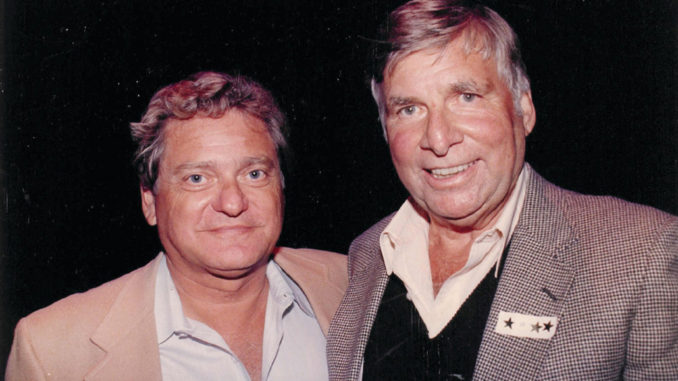
by Michael Kunkes
The original Star Trek series, which ran on NBC from 1966 to 1969, boldly went where no series had gone before in terms of sound effects editing. The universe of the USS Enterprise was alive with sound, much of it musical in nature: computer banks, phasers, transporters, photon torpedoes, communicators, and alien and creature vocals. Much of that was due to the singular vision of writer/producer Gene Roddenberry, along with the inventiveness of Douglas H. Grindstaff, who served as the show’s supervising sound effects editor for the entire 80-episode run.
Grindstaff, who entered the industry in 1954 after service in the Korean War, won five Emmy Awards for his television sound work as well as the Motion Picture Sound Editors’ Lifetime Achievement Award in 1998. He also headed the sound departments at Paramount Studios, Lorimar Telepictures, Columbia Studios and Pacific Sound before his retirement in 1990.
“When I went to work on the series, Gene described to me what he wanted the Enterprise to sound like,” Grindstaff recalls. “I asked him if he didn’t think we were getting a little too ‘cartoony’ with the sound effects, and he told me, ‘Doug, I want you to think like an artist and paint everything with sound.’ That’s what he wanted, and that’s why the show sounded the way it did. He had a very strong vision; you had to give him what he wanted, but you also had to use your own instinct about what should be. You were either on his wavelength or you weren’t.”
Grindstaff and his crew built their tracks mainly from some material in the Paramount and Desilu sound effects libraries, as well as their own personal libraries. Additional sounds came from Paramount’s 1953 version of War of the Worlds . Sadly, the library he meticulously created, bundled and catalogued is now lost to history.

Working with small TV budgets, Grindstaff maximized what he had. For example, to create the shimmering, musical sound of the Enterprise transporter, he blended together a few musical effects and electric generator sounds. Then, on a Moviola, he would create his own fades by shaving the mag sound with a razor blade at the desired point, a technique he learned from the late George Emich, who was Fred Astaire’s music editor at RKO, and who is co-credited with applying the click track to music editing. “I created my own fades because I didn’t trust the mixers to get it the way I wanted it,” Grindstaff laughed. “We also did all our own Foley and ADR looping.”
Other sounds were just as inventive. At Roddenberry’s insistence, each planet visited by the Enterprise had to have its own sound, and for these, Grindstaff would use variations of an orchestra tuning up. In one legendary episode, “The Trouble with Tribbles,” Grindstaff used screech-owls, doves and rat “vocals” for the voices of the furry pets, who came aboard the Enterprise and began reproducing at an alarming rate. “I had to go from a single Tribble to the sounds of thousands of them filling the ship,” he says. “I ran them backwards and forwards, put them on the variable speeder and edited loops, so I could have multiple tracks and mix them at different levels for different spots in the ship.”
The schedule was brutal. “You were making things every week, and that was the tough part,” he recalls. “I’d try and get as much ready as I could a couple of weeks before we got an episode, so that when the show was turned over to the editors, I had the sound effects pretty well set, and could tell them the right spots to put everything. I also always insisted on having a sound effects editor at every mix.”
Nearly ten years after the Enterprise concluded its five-year mission, Grindstaff was offered a job by Roddenberry on Star Trek: The Motion Picture (1979). He turned it down. “Not long before that, I had gone to see Star Wars , and I flipped out,” he says. “I just said to myself, ‘Man, we blew it; we should have made a Star Trek movie a lot sooner.’ But I sure intend to go see this one.” Was he aware that he was creating something entirely new in sci-fi sound effects? “Hardly; I was too busy working for Gene.”

- Sound Editors

Related Articles

Carole Kravetz Aykanian Talks About Editing Steve Carell and Jennifer Aniston in ‘The Morning Show’
“The pilot was the foundation. We had to find the tone.” […]
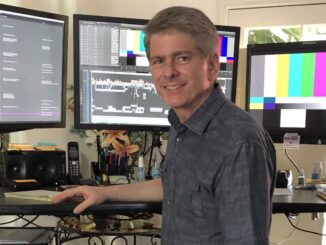
What Our Members Do: John Axelrad, Picture Editor
“There was a click track, but it was completely useless—because this was live JAZZ!” […]

WHAT OUR MEMBERS DO: Priscilla Zambrano, Assistant Editor
Everything in this industry is about collaboration, and part of my job is to make sure that my editor’s day goes as smoothly as possible. […]
©2016-2021 Motion Picture Editors Guild
Kittens, Kisses, And Razorblades: Behind Star Trek's Iconic Sounds
Play with our soundboard and get the inside scoop on how sounds effects wizards took sci-fi where it had never gone before.
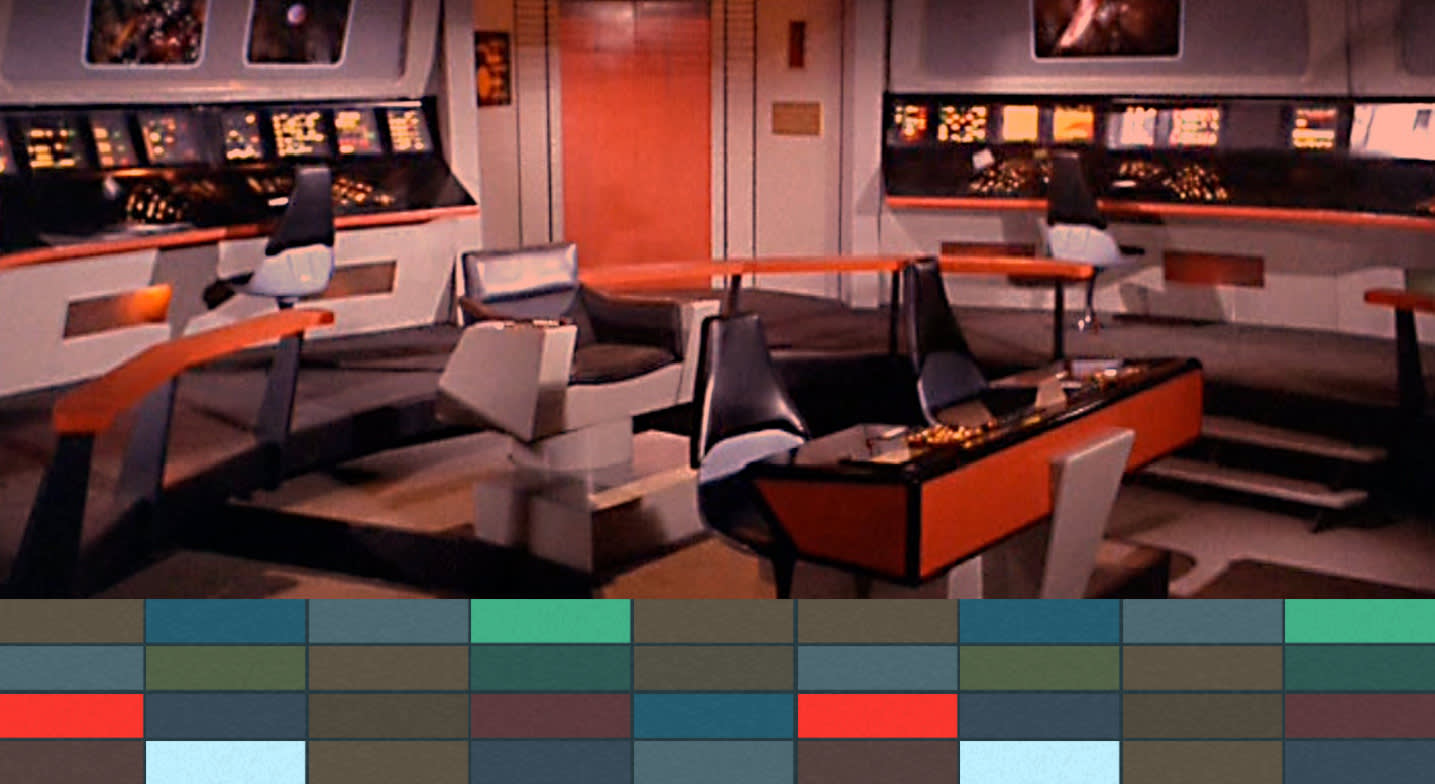
It may be true that in space no one can hear you scream, but in the Star Trek universe, space is a fairly cacophonous place filled with explosions, starships warping across the galaxy, phasers firing, and grunting lizard men engaged in mortal combat with the heroic Capt. James T. Kirk. Some of these effects are among the most memorable ever created for the medium that FCC chief Newton Minow once famously referred to as “a vast wasteland.”
Back in 1966, Doug Grindstaff, sound mixer for the original Star Trek series, didn't realize at the time he was making TV history. In fact, he didn't even have a parking pass on the Desilu lot. Laughing about it now, he says he had the art department forge and laminate a pass for him, prompting studio executive Herbert F. Solow to proclaim, “You guys are really creative.”
How creative they were is abundantly clear to anyone who has ever seen — or heard — the original series. The wall-to-wall sound effects were created in an analog world in which all audio was cut and mixed on magnetic tape, long before the advent of software-based sound tools. Each of the Enterprise sets had its own sonic “feel” — the chirp and ping of various sensors and instruments on the bridge, the throb of power in the transporter room and the deeper sound of power generators in engineering. This created the illusion of a massive space vessel where every part of the ship had its own distinct aural environment. The show’s space effects, while expertly done, were simple, so the rumble of the Enterprise’s engines and the sounds of phasers, photon torpedoes, and other energy forces (while they wouldn't really be heard in the vacuum of space) helped create the illusion of real, futuristic technology at work.
“I think the sound effects for the original Star Trek are probably the most memorable and iconic ever produced for television.”
“The first season we had about 10 editors,” recalls Grindstaff, who worked on all three seasons of the original Star Trek as well as the two pilots “ The Cage ” (the original pilot) and “ Where No Man Has Gone Before .”
“I said, ‘This is ridiculous. I can do it with three editors if you give me good men and myself. That’s all I need. Get the others out of here,’” says Grindstaff. “Then I had three editors and myself and we did the show. But what I would do is create the stuff and then they would put it in. It just worked. On the original pilot, I would get in at 7 o’clock and [executive producer] Gene Roddenberry would be there. I would get out at 2 o'clock the next morning. That’s a long day. And you’d work Saturday, Sunday, holidays. Nothing mattered. I enjoyed it. The people you were working with were great.”
“I think the sound effects for the original Star Trek are probably the most memorable and iconic ever produced for television,” offers Jeff Bond, the author of The Music of Star Trek and a distinguished Trekspert. “They were done at a time when people watched television sets that mostly had a single, small, monophonic speaker, and when there was nothing like the immersive, multi-layered sound mixes that movies started getting in the late '70s, and which television showcases today. The show’s sound editors Douglas Grindstaff, Jack Finlay, and Joseph Sorokin not only created extremely innovative and unique-sounding effects, they also created entire sonic environments for the starship Enterprise and the different planets the ship would visit.”
Grindstaff, who was nominated for an Emmy Award for the first season, first came to Hollywood upon returning from Korea, at the behest of his brother, who was working in radio. He first heard of a new pilot called Star Trek in 1965 while working on another series called Swinging Summer, a precursor to Charlie’s Angels . “I was over at Goldwyn Studios when the phone rang and the head of the sound department introduced me on the phone to Gene Roddenberry. Gene had heard about me, and they needed someone to come over and help them on Star Trek. Gene was really into sound. On one episode that Gene liked very much, he sent me a memo with 11 pages of notes handwritten about the sound.”
Courage even created the familiar “swish” of the Enterprise for the opening title sequence by blowing air across a microphone himself.
“There was a wonderful musicality to the consoles — the whistles and clicks,” says Lukas Kendall, publisher of Film Score Monthly and a producer on a number of Star Trek soundtrack releases. “The sound effects got the balance just right between acoustic and electronic, futuristic yet timeless. There was a sonar ping to the viewscreen that you can practically whistle to yourself, it’s so melodic. It created this sense of a wondrous future where technology was our friend and not something to be feared.”
“One of the reasons that the show’s effects are so distinctive and memorable is that they are often musical, and that goes back to the first composer who created music for the series, Alexander Courage,” says Bond. “When Courage was working on the show’s first pilot, ‘The Cage,’ he was assisted by a man named Jack Cookerly, one of the session keyboardists, who had modified one of the electric organs of the period to make strange ‘electronic’ sounds.”
“A lot of the sound effects were generated by musical means at the end of recording sessions with the orchestra,” says Kendall. “Cookerly had a device he called a ‘music box’ — a reconstructed Hammond organ — that laid the basic tracks for the transporter effects, the medical scanners in sickbay, and other sounds.”
During the recording sessions, Courage took the time with Cookerly and some of the session musicians to create sound effects for the show, including the transporter sound, strange atmospheric and wind-chime sounds for the planet surface, the weird “thunk” of Capt. Christopher Pike (later to become Capt. Kirk) hurling himself against a transparent barrier confining him in an alien zoo, and numerous other sounds. Courage even created the familiar “swish” of the Enterprise for the opening title sequence by blowing air across a microphone himself.
“Gene Roddenberry wanted to paint the whole show like you were painting a picture,” says Grindstaff. “And he wanted sounds everywhere. One time I asked him, ‘Don't you think we're getting too cartoony?’Because I felt it should be a little more dignified, but he wanted sound for everything. For example, I worked on one scene where [Dr. McCoy] is giving someone a shot. Gene says, ‘Doug, I'm missing one thing. The doctor injects him and I don't hear the shot.’I said, ‘You wouldn't hear a shot, Gene.’He said, ‘No, no, this is Star Trek , we want a sound for it.’So I turned around to the mixing panel and I said, ‘Do you guys have an air compressor?’And they did. I fired up the air compressor, squirted it for a long enough period by the mic, went upstairs, played with it a little bit, and then put it in the show. And Gene loved it. So, that’s how Gene was. He didn't miss nothing!”
“The pneumatic ‘whoosh’ of the doors sliding open became a running joke in Airplane II with William Shatner.”
Adds Bond, “Later they adapted and expanded on these sounds, often using the tones of an electric organ [the first keyboard synthesizers were enhanced versions of these instruments and became available to the show’s composers during the second season]. The recorded tones had to be manipulated by using tape techniques — speeding up, slowing down, adding reverb or echoes to the tones. Some of the familiar effects came from Paramount’s own sound-effects library. The photon torpedo sound was originally created for the “skeleton ray” in George Pal’s War of the Worlds , and some other Trek sound effects can be heard in the low budget sci-fi movie The Space Children. The effects, like the show’s music, were crucial in creating its verisimilitude. The show’s planet sets, created on a soundstage, couldn't reproduce the scope of a real exterior or even of a bigger-budgeted film production, so the ambient sounds helped to convince viewers they were in an alien environment.
"So many of the sounds became part of the culture,” says Kendall. “We all know what the transporter sounds like, and the phasers and the communicators. Much like actors, they had great personality and were easy to remember. The pneumatic ‘whoosh’ of the doors sliding open became a running joke in Airplane II with William Shatner."
Other iconic sounds in Star Trek included the Tribbles. In the case of these famous furry and fertile pets , Grindstaff took the sound of a dove and played with it. Says Grindstaff, “You'd slow it down, you'd speed it up, turn it backwards, stick a razorblade on the mag [audiotape track]. I would use scissors to cut it. I would use sandpaper. I would use emory board. I would use steel wool. Anything that I could do to make things work. And you could take a sound and you could speed it up and speed it up again and again and a new sound would come out."
Other classic sounds Grindstaff created for the series include the sound of the neural parasites in the episode “Operation: Annihilate,” made by sampling about a hundred kisses, a secret he refused to share with his producers. Meanwhile in “Catspaw,” featuring an ominous giant black cat, Grindstaff brought in a dog to antagonize the cat that provided the required hiss. In “Amok Time,” the Vulcan gong was a combination of a guitar’s electronic twang and the sound of the actual gong being struck on set.
"The sound effects were so brilliant in selling the futuristic environment that they liberated the music scores to focus on the storytelling,” says Kendall. “Sci-fi scores until that point often had eerie theremins and atmospheres, but Roddenberry wanted the scores to emphasize timeless human drama."
So why, after five decades, does Star Trek continue to endure? It’s a mystery even to those who worked on the original show. “If I had only known, I would have kept stuff like you wouldn't believe,” laughs Grindstaff. “But I didn't realize it. No one did.”
More Trek Stories, Both True And Fictional

Star Trek: Avenger (Adapted)

The Fifty-Year Mission: The Complete, Uncensored, Unauthorized Oral History of Star Trek: The First 25 Years

To The Stars

The Hidden Histories of Black Americans

The History of Institutionalized Racism and Oppression

Exceptional Tween Fiction by Black Writers and Narrators

'Boys Come First' Is an Exuberant Expression of Queer Joy and Struggle in Detroit
- Interactive
- AV Undercover
Read This: The story behind Star Trek ’s iconic, ceaseless sound effects
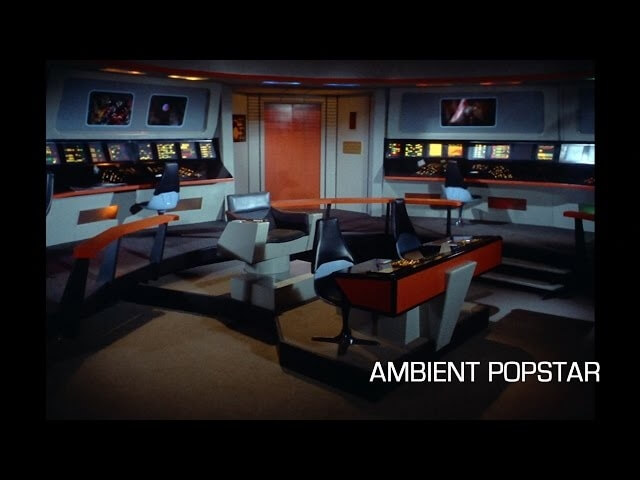
Very few programs in television history can be easily identified by their sound effects alone. The original 1966-69 run of Gene Roddenberry’s Star Trek belongs in that select fraternity, thanks to the efforts of sound mixer Doug Grindstaff and other craftsmen who toiled on the classic science-fiction series, setting the tone for the multimedia franchise to come. The sound effects on Star Trek are as cool as they are relentless. This is, in short, a noisy version of space exploration. Despite the supposed lack of oxygen in the vast reaches of the cosmos, the onslaught of beeps, bleeps, pings, clicks, and whooshes never really stops during the average Trek episode. And that’s wholly by design. Over at Audible Range , having interviewed Grindstaff and other experts on the topic, writer Mark Altman has assembled a revealing historical article entitled “ Kittens, Kisses, And Razorblades: Behind Star Trek ’s Iconic Sounds .” Here, to set the proper mood, is some genuine LBJ-era Trek ambiance.
- God help us, Reacher is getting even bigger
- Internet Archive loses copyright case against publishers
- The best 4K and Blu-ray releases coming out in September
According to the article, the show had “wall-to-wall sound effects” because Roddenberry wanted it that way. Cacophony was very much part of the Star Trek brand. In those early days, the TV series did not have the budget to compete with feature films, so sound effects helped create the illusion that scenes were taking place on strange alien worlds. Roddenberry wasn’t aiming for realism but drama. So committed was Roddenberry to this idea that he even had Grindstaff add a sound effect to a scene in which Dr. McCoy (DeForest Kelley) administers a shot. “Gene Roddenberry wanted to paint the whole show like you were painting a picture,” Grindstaff explains.
Some tricks of the trade are also revealed here. Composer Alexander Courage, who created the original music for Star Trek , was hugely important in determining how the series would sound, working hand in hand with effects people to create weird, often electronic-based noises. Certain noises, however, were decidedly low-tech. When the Enterprise swooshes across the screen during the opening credits, for instance, that’s Courage himself blowing into a microphone. The sound of the Tribbles, meanwhile, came from doves, while the parasites of “ Operation: Annihilate ” were represented by “sampling about a hundred kisses.” Fascinating, Captain.
- 5 things to watch on TV this weekend
- TV Club 10: Homicide: Life On The Street 's most unforgettable episodes
- The Front Room wears out its welcome as quickly as its in-law from hell
- Universal finally drops first teaser for their long-gestating Wolf Man remake
GET A.V.CLUB RIGHT IN YOUR INBOX
Pop culture obsessives writing for the pop culture obsessed.

Was Remastering Star Trek: TOS Necessary? – Mike Matei Blog
In 2006, a Remastered version of Star Trek: The Original Series was attempted. Beyond simply moving the show into an HD screen format, every special effect shot in the series was replaced with computer generated ones. Now, if you try to watch this series on Netflix, these “modernized” versions are the only things being offered.
When the Star Wars Special Editions were being teased before their release, I have to admit I was somewhat into the idea. Something like that had never really been attempted before. Who knew, maybe if it was executed artfully it could be great? I was willing to at least give it a chance. But sure enough, sitting in the theater and watching all these classic scenes with weird rubbery, shiny CGI monsters pasted over the film footage it became clear pretty quickly that these kinds of remasters just aren’t a good idea.
A Jim Henson Muppet looks more like a living creature than this.
But, I’ve been curious about whether it’s the execution of these remasters that make them bad, or if doing special-effects remasters is even worth attempting in the first place? After a lot of thought, I want to make the case for the latter.
My gut reaction on watching the Remastered version of Star Trek: TOS was I had an intense desire to turn it off and watch the originals. But why? Why am I so much more interested in the original special effects instead of these new ones?
I’m not going to pretend like there’s not some aspect of psychological bias to this. We do have a tendency to like the versions of things we’ve seen first. You’ve likely heard cover versions of your favorite songs that you absolutely didn’t like, or read a book that got adapted into a movie you didn’t like. But does this always happen? There are good cover songs and there are good book adaptations. It can’t just be the case that our brains just latch onto the first thing we see and that’s the only version we’ll find acceptable. There has to be more to this than that.
There’s a lot to unpack here, so let’s go point by point:
Stylization vs. Realism
There’s not one singular goal that all artists should strive towards. If depicting reality with as much precision as possible was the only goal of every artist, then we wouldn’t have animation or abstract art. Likewise, we can’t just have everything be stylized either, because realism has weight and grandeur that draws from the existing beauty of nature. Both are worthwhile goals, and we want to have a world that has many different types of art in it.
Star Trek: TOS’s special effects were originally designed with many goals, but hyper-realism wasn’t one of them.
I’d like to think the special effects designers wanted to make things visually interesting and give these space-adventure scripts that were being written for the show the chance to come alive. Of course, they wanted to stay under-budget as well, but I’m not entirely sure they would have gone for as much realism as possible even if they had more money to do so.
If you take in everything visual about TOS besides the special effects, it’s very clearly a show that is intended to be stylized. Look at the set and costume designs, look at the color schemes and abstract lighting used. The realism came from the stories and the performances, but the show was supposed to be colorful and almost dreamlike. Later Star Trek series aimed to be visually realistic but TOS was after something different. This is a stylized show, and it’s not intended to be realistic looking.
Attempting to enhance the realism of TOS’s special effects goes against what the show was trying to do visually, and that’s why the Remastered version sucks all the beauty and fun out of each frame.
Inconsistency
The opening theme song to the Remastered version is the moment when people like me who don’t like this version instantly start to get turned off.
It seems at first that they did their best job. The new theme song is competently recorded and performed well by a live orchestra, but why does it sound terrible? It’s because as soon as the theme song ends, the normal episode’s audio comes in and there’s a drastic difference between the nature of the sound between the two. To be incredibly non-technical about this, the original audio has a “grain” to it that the new recording doesn’t have, and the difference between the two is very jarring and impossible to miss.
This new recording doesn’t sound like it came from the 60s, and even someone who didn’t grow up in the 60s can recognize this fact. And the big kicker is, if they had put a filter over the new audio to clear up the inconsistency, then they might as well have just kept the original! It’s such a waste of everyone’s time and money.
The same thing applies to the special effects. No matter how much effort they put into making an establishing shot of the Enterprise orbiting a planet look beautiful and polished, we’re still going to cut to the bridge and see the 60s set design and 60s costume design filmed with cameras from the 60s. The juxtaposition of the two is off-putting and doesn’t blend together well. And the solution to this problem leads back to the same problem with the theme song, trying to build CGI scenes that look like they’re from the 60s will just lead right back to the easier solution of just keeping the footage unaltered.
Now, there are some arguments that could be made for a remastered version like adding more variety to the planets that the Enterprise visits or composing more action-packed space battles, but that leads me to my next point…
Old Things Should Stay Old
Old films and television are always going to have a special quality to them. They were made with very different equipment by very different cultures. They’re always going to have a unique flavor to them that modern creators can only approximate, but never truly imitate.
Star Trek: TOS is a product of the 60s. It was being influenced by, and was influencing the culture of its time. There’s always going to be a historical context to what you’re watching even if you’re completely uninterested in the history of the 1960s, because this show will have a strange quality to it that is very different from the type of shows that are being produced today.
I’ve spent much of my adult life in the pursuit of historical pop-culture preservation along with James, so of course I would have this opinion. But I really do think that not only is it important for history to be preserved in instances like Star Trek, the old special effects are more interesting.
It’s interesting to see what was possible with visual effects in earlier generations. Sometimes we are amused by how crappy old style monsters and laser effects looked back in the day. But when you see a special effect from an old movie that looks amazing and still holds up by today’s standards? That’s a special kind of emotion that is exclusive to watching old things.
Also, old things are cool. Show me a group of teenagers here in 2017 and I guarantee you at least one of them is into music, movies, video games or fashion from the 80s or 90s, or even things that are older. It’s not just nostalgia, and you don’t have to live through an era to be fascinated by it.
Overwriting old special effects with newer ones robs the viewer of the unique viewing experience they get watching such an old show.
Star Trek: TOS’s Original Effects Are Actually Good
I’ve seen the original model for the Enterprise at the Smithsonian Air and Space Museum. It’s an absolutely beautiful piece of craftsmanship and an amazing sight to see in real life. I actually stood and looked at it for over an hour inspecting it from every angle. As I was looking at it, the thought in my head was “I am looking at what is probably the single greatest object on the face of the planet”.
I can understand perhaps preferring a well animated CGI dinosaur to an animatronic robot one. But a spaceship? What can you possibly do with a spaceship that can’t be accomplished just as well with a model, unless it’s some kind of bizarre alien spaceship made out of flesh or goo or energy?
CGI photorealism has the same goal as filming a practical model. You’re trying to simulate a fantasy object, so you want to create a model that has a sufficient amount of detail and use materials that catch light in the correct way. Real spaceships have sort of a sterile, plastic look to them, so making models out of plastic or smooth painted wood gets the exact look you’re going for. That’s why the special effects in 2001: A Space Odyssey hold up so well. It’s definitely the case that filming a real model, if done well enough, will look identical or very close to putting an actual spaceship into space and filming it flying around. That’s why The Orville built a model of their show’s main ship and filmed practical effects flybys with it, even in 2017 where CGI is the industry standard. The model is always going to look superior.
Practical effects vs CGI effects are like two different genres to me. One is better than the other depending on the task. CGI definitely beats out practical effects if you wanted to make a swarm of alien bugs, but if you want to explode a building, a CGI explosion is not going to look as good as blowing up a practical model, at least with today’s technology. Each one still has an application where it shines over the other.
I don’t want to be too mean to the Remastered special effects team. They did do a pretty good job considering it was 2006, and parts of the Enterprise model, especially the nacelles, look good. But the original model looks more like a real object and the Remastered version definitely looks like the fake CGI thing that it is.
Now, the Botany Bay in the episode Space Seed with its blurry textures looks straight out of an N64 game. In no way can it can be considered to be even close to being as good as the original, and in no way better. There are plenty of other examples of the Remaster just being absolutely hideous, but I don’t want to be too cruel after I’ve spent all this time criticizing it in this post.
It’s like I’m looking at a screenshot of Wing Commander 3 (Now available for Windows 95 and MS-DOS).
I believe the Remastered version of TOS was made with good intentions. You can certainly see why the idea was pitched and why the plan went forward. I think, like the Star Wars Special Editions, we needed to see this experiment tried before we could see why it’s not a good idea.
Unfortunately, Remastered only version of TOS you can watch on Netflix at the time of this writing. It’s time to put this failed experiment behind us and revert the official version back to the original, which the cast and crew got right the first time.
18 thoughts on “Was Remastering Star Trek: TOS Necessary? – Mike Matei Blog”
A good write-up, and I agree with you. I’m actually planning on getting “Star Trek 50th TV and Movie Collection” on blu-ray. Do you happen to know if it’s the original, remastered, or both? I can’t find any confirmation on it. Just thought you might know. Thanks.
I’m not sure. I’ve gone back to watching them on VHS lately haha. Thanks for reading!
The TOS Blu-Rays contain both versions (original and remastered).
Yeah, but it defaults to the remastered versions. It should default to the originals.
I feel they should have been remastered for HD, but not tampered with in any way artistically. Like you I say leave the original special effects (and audio) there because the new ones call too much attention to themselves and don’t really fit. Sure, clean up the film to get rid of any dirt, negative dirt and scratches and then use CG for anything that cannot be repaired chemically, but that’s as far as any kind of CG works should go. Star Trek was shot and edited on 16mm film if I recall and that exceeds the resolution that HD is capable of when done properly. Its nice seeing the episode appear closer to the way they shot it with film grain, the bob and weave of the camera gate, and much more detail. Sometimes this detail can be a detriment. They were often pretty lazy with the focus knowing that NTSC TV was TEH SUXORZ (which I’m sure is the phrase they used in the 60’s) and there are other details you can make out like the computer monitor screens being paper, etc. To me though this is all part of the charm. Can’t wait until they CGI Chekov walking around the ship and encountering Khan in Space Seed, though.
Totally agree about the quality upgrade since it was shot on film. They do look nice on blu-ray when you’re watching the original versions. Thanks for visiting the blog
When releasing something that is decades old, companies should remaster and restore the original elements the best they can… but the final product should be 100% faithful to what the original movie/series did.
I can’t see the appeal to “modernize” something like this. And if you do it (because you think sales will increase), at less give the option to watch the original version too.
Hey Mike. Totally agree with you. The Next Generation is also on Netflix. Do you now if that series got remastered too?
Yes it did, in a sense. They went back a few years ago to the original film negatives, cleaned them up and reassembled them from scratch. TNG has never looked better (if you get the bluray ones). ORiginally it was output to video. Now it retains the details that a film strip would give it. Well worth the upgrade to Bluray to see the vibrant colors and remastering! Plus all the bloopers, deleted scenes and extras they have dug up. Unfortunately, the set did not sell super well and so we will not get versions of DS9 or VOY that way.
And Mike on your blog post here, as a longtime Trek fan, I didnt mind the remastering. At least they didnt step on the toes of the old versions too much and gave BOTH options when they released it… rather than saying OH THIS IS THE ONLY VERSION THAT EXISTS NOW. Its sorta just a fun little experiment done with some love, I think. Im just glad I got the OPTION to choose which to watch!
Good blog, keep em coming, sir!
I don’t like that the Blu-rays default to the new versions. If it didn’t do that, it would piss me off less. It’s the arrogance of them covering up the original versions with the new versions that irks me the most. I agree the film restoration clean up is fantastic. Thanks for reading.
I wouldn’t necessarily say they are covering up the originals, not like Star Wars is. It is rather that that they are promoting their remastered version (as that is where the mostly spent the money, doing the actual film restoration did not cost as much).
I love old film as well and, while I do not feel it is 100% necessary, I do appreciate the intentions involved when creating the remaster (which I do like too). There are a lot of people who refuse to watch the original trek and some of the original effects turn people off who would otherwise enjoy the series just fine. I believe that this was what the goal was with Star Wars except they went absolute there and refused to acknowledge the original theatrical releases.
The 50th anniversary set was one of the best restoration sets I’ve seen on Blu Ray (the TAS looks great and all of the movies are unchanged).
I’d highly recommend the Blu Ray sets for TNG as well.
As soon as I see a remastered Star Trek Episode I turn it off and stop watching. The cheesy effects is what got me hooked as a young kid, and making me forever a Trekkie.
This style of CGI remaster came too early imho. The graphics look barely as good as the ones in ST: Enterprise – which aren’t great, although that may be a result of having it added onto old footage. If a CG remaster were to be done, It should have been produced sometime around “nowadays”, 2006 was just a bit too early for the tech AT THE BUDGET THEY HAD. If this were done today with something ridiculous like CBS throwing 1 million dollars per episode into a CGI remaster, maybe we could have gotten something that resembles some of the more modern shows and films instead of a TOS + plastic CGI models. (Replacing originals that often were actual plastic, but better!)
Here’s what I think. When remastering stuff from film, they should get a high as possible resolution on the base master, and then fix some stuff if necessary and leave it alone, they should not change the aspect ratio either, just leave it the way it’s intended to be. Same with audio tampering, maybe cleaning that up a bit if necessary, but not try to mix it again. Hate it when there’s something that’s originally Mono or Stereo and it’s made to 5.1 or something, and naturally leaving the original audio track choice out (Region 2 suffers from this at least from what I’ve seen and heard). Pretty much what I think is “don’t change the thing to be something it’s not”. Unless it’s something already in the first place I don’t mind.
The Directors Edition of Star Trek: The Motion Picture is perhaps the gold standard for remastering with new FX.
They intentionally added grain/noise to the new FX to make them match the original, among other things.
Watching the director’s edition, it’s hard to believe anything was even done, unless you compare it to the original. This is not at all true of the TOS remasters. The external shots of the Enterprise are far more detailed than the interior shots, and the planets and other spatial phenomena look ridiculously good. The Enterprise herself just looks like a highly detailed model. Whether it was done with a computer model or not, the detail simply doesn’t stand up to this level of graphics resolution.
The TNG remasters look spectacular though because the 1701D does have enough detail to appear in HD and the actual live action film is of HD quality as well.
Re-editing with modern effects is like re-writing some historical events so that women suddenly also play an important role where they never did before.
Where can I see TOS episodes with the original special effects, which I love, online? Not CBS Total Access, apparently.
You can watch both versions on Amazon Prime.
Comments are closed.
Adobe Community
- Global community
- 日本語コミュニティ Dedicated community for Japanese speakers
- 한국 커뮤니티 Dedicated community for Korean speakers
- After Effects
- Discussions
- Tutorial: Recreating the Transporter effect from S...
Tutorial: Recreating the Transporter effect from Star Trek: TNG

Copy link to clipboard
Have something to add?
never-displayed
- More to Explore
- Series & Movies
Published Sep 3, 2024
Celebrate the 45th Anniversary of Star Trek: The Motion Picture with This Limited Edition Release
Bring home this release on November 19!
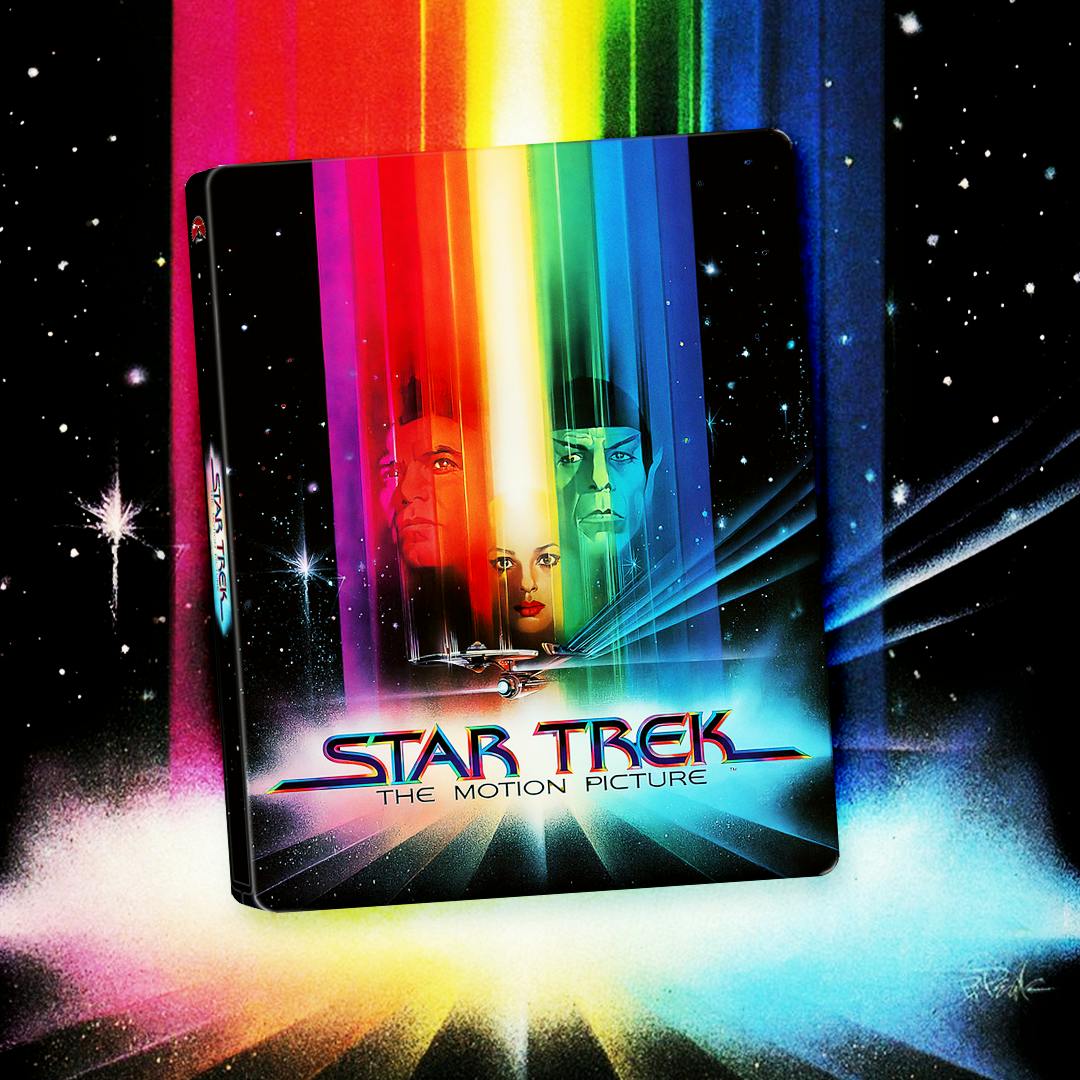
StarTrek.com
Set a course for the final frontier!
Celebrate the 45th anniversary of Star Trek: The Motion Picture by bringing home this limited-edition Steelbook, featuring the original theatrical cut in 4K Ultra HD, and a bonus remastered Blu-ray, from Paramount Home Entertainment on November 19.
This bold blockbuster launched one of the longest running movie franchises, reuniting the cast of the original Star Trek series, including William Shatner, Leonard Nimoy, DeForest Kelley, George Takei, Nichelle Nichols, Walter Koenig, and James Doohan. The adventure begins when an unidentified alien intruder destroys three powerful Klingon cruisers. Captain James T. Kirk returns to the helm of a newly transformed U.S.S. Enterprise to take command. As a bonus, an exclusive booklet boldly explores the original marketing materials and behind the scenes images from the Paramount Archives.

Originally released in 1979, Star Trek: The Motion Picture became the fourth highest grossing movie of the year and earned three Academy Award nominations for Best Visual Effects, Best Art Direction, and Best Music, Original Score. The film successfully launched the Star Trek franchise beyond the original television series, despite having been rushed to theaters with incomplete special effects and forced editing choices.
Get Updates By Email
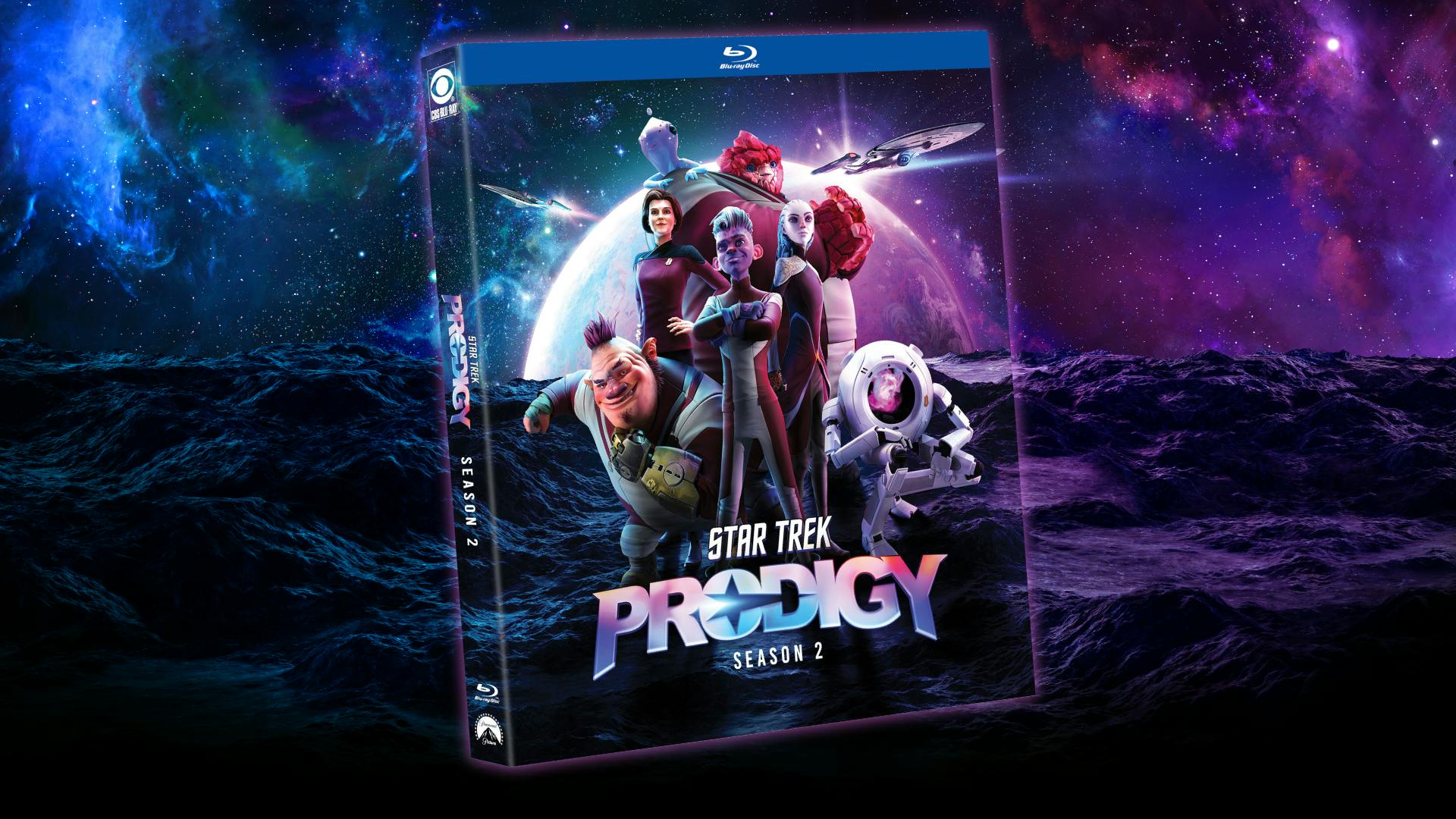

- Movies & TV
- Featured Categories

Enjoy fast, free delivery, exclusive deals, and award-winning movies & TV shows with Prime Try Prime and start saving today with fast, free delivery
Amazon Prime includes:
Fast, FREE Delivery is available to Prime members. To join, select "Try Amazon Prime and start saving today with Fast, FREE Delivery" below the Add to Cart button.
- Cardmembers earn 5% Back at Amazon.com with a Prime Credit Card.
- Unlimited Free Two-Day Delivery
- Streaming of thousands of movies and TV shows with limited ads on Prime Video.
- A Kindle book to borrow for free each month - with no due dates
- Listen to over 2 million songs and hundreds of playlists
- Unlimited photo storage with anywhere access
Important: Your credit card will NOT be charged when you start your free trial or if you cancel during the trial period. If you're happy with Amazon Prime, do nothing. At the end of the free trial, your membership will automatically upgrade to a monthly membership.
Buy new: #buybox .a-accordion .a-accordion-active .a-price[data-a-size=l].reinventPriceAccordionT2 .a-price-whole { font-size: 28px !important; } #buybox .a-accordion .a-accordion-active .a-price[data-a-size=l].reinventPriceAccordionT2 .a-price-fraction, #buybox .a-accordion .a-accordion-active .a-price[data-a-size=l].reinventPriceAccordionT2 .a-price-symbol { top: -0.75em; font-size: 13px; } $61.22 $ 61 . 22 FREE delivery Wednesday, September 11 Ships from: Amazon.com Sold by: Amazon.com
Return this item for free.
We offer easy, convenient returns with at least one free return option: no shipping charges. All returns must comply with our returns policy.
- Go to your orders and start the return
- Select your preferred free shipping option
- Drop off and leave!
Save with Used - Good #buybox .a-accordion .a-accordion-active .a-price[data-a-size=l].reinventPriceAccordionT2 .a-price-whole { font-size: 28px !important; } #buybox .a-accordion .a-accordion-active .a-price[data-a-size=l].reinventPriceAccordionT2 .a-price-fraction, #buybox .a-accordion .a-accordion-active .a-price[data-a-size=l].reinventPriceAccordionT2 .a-price-symbol { top: -0.75em; font-size: 13px; } $49.90 $ 49 . 90 FREE delivery September 21 - October 2 Ships from: Amazon Sold by: Collect&ShipLLC
Image unavailable.

- Sorry, this item is not available in
- Image not available
- To view this video download Flash Player

Star Trek: The Original Series: The Complete Series
- Blu-ray $61.22
Purchase options and add-ons
Frequently bought together.

Customers who bought this item also bought

From the manufacturer

The great adventure of all time begins with Star Trek, the incredible story of a young maiden voyage onboard advanced starship: the U.S.S. Enterprise. On a journey filled with action, comedy and cosmic peril, the new recruits must find a way to stop an evil being whose mission of vengeance threatens all of mankind. The fate of the galaxy rests in the hands of bitter rivals. One, James Kirk (Chris Pine), is a delinquent, thrill-seeking Iowa farm boy. The other, Spock (Zachary Quinto), was raised in a logic-based society that rejects all emotion. As fiery instinct clashes with calm reason, their unlikely but powerful partnership is the only thing capable of leading their crew through unimaginable danger, boldly going where no one has gone before.
Product Description
Star Trek: The Original Series, Three-Season Pack Blu-ray - Paramount Pictures 1966-1969 3 Seasons 4062 min Not rated "Space... The Final Frontier. These are the voyages of the Starship, Enterprise. It's 5-year mission: to explore strange new worlds, to seek out new life and new civilizations, to boldly go where no man has gone before!" The series is set in the 23rd century where Earth has survived World War III then moved on to explore the stars. Brought to you in a brilliant remastered edition... this is Star Trek like you've never seen it before! Director: Vincent McEveety Writers: Gene Roddenberry, Gene L. Coon, D.C. Fontana, George Clayton Johnson Starring: William Shatner, Leonard Nimoy, DeForest Kelley, Nichelle Nichols, James Doohan, George Takei
Product details
- Is Discontinued By Manufacturer : No
- MPAA rating : NR (Not Rated)
- Product Dimensions : 0.7 x 7.5 x 5.4 inches; 0.01 ounces
- Item model number : 35386474
- Media Format : Subtitled
- Run time : 68 hours and 41 minutes
- Release date : June 14, 2016
- Actors : Nichelle Nichols, George Takei, James Doohan, DeForest Kelley, Walter Koenig
- Dubbed: : French, Spanish
- Subtitles: : French, Spanish, English, Portuguese
- Studio : PARAMOUNT
- ASIN : B01CJW334Q
- Country of Origin : USA
- Number of discs : 20
- #7,047 in Blu-ray
Videos for this product

Click to play video

Customer Review: Review Of Star Trek Original Series Blu Ray Version By Author Bart Gnarly
Bart Gnarly
Customer reviews
- 5 star 4 star 3 star 2 star 1 star 5 star 84% 9% 3% 1% 2% 84%
- 5 star 4 star 3 star 2 star 1 star 4 star 84% 9% 3% 1% 2% 9%
- 5 star 4 star 3 star 2 star 1 star 3 star 84% 9% 3% 1% 2% 3%
- 5 star 4 star 3 star 2 star 1 star 2 star 84% 9% 3% 1% 2% 1%
- 5 star 4 star 3 star 2 star 1 star 1 star 84% 9% 3% 1% 2% 2%
Customer Reviews, including Product Star Ratings help customers to learn more about the product and decide whether it is the right product for them.
To calculate the overall star rating and percentage breakdown by star, we don’t use a simple average. Instead, our system considers things like how recent a review is and if the reviewer bought the item on Amazon. It also analyzed reviews to verify trustworthiness.
Reviews with images

The Best of Both Worlds (Or "What George Lucas should have done when he released the Original Trilogy on Disc")
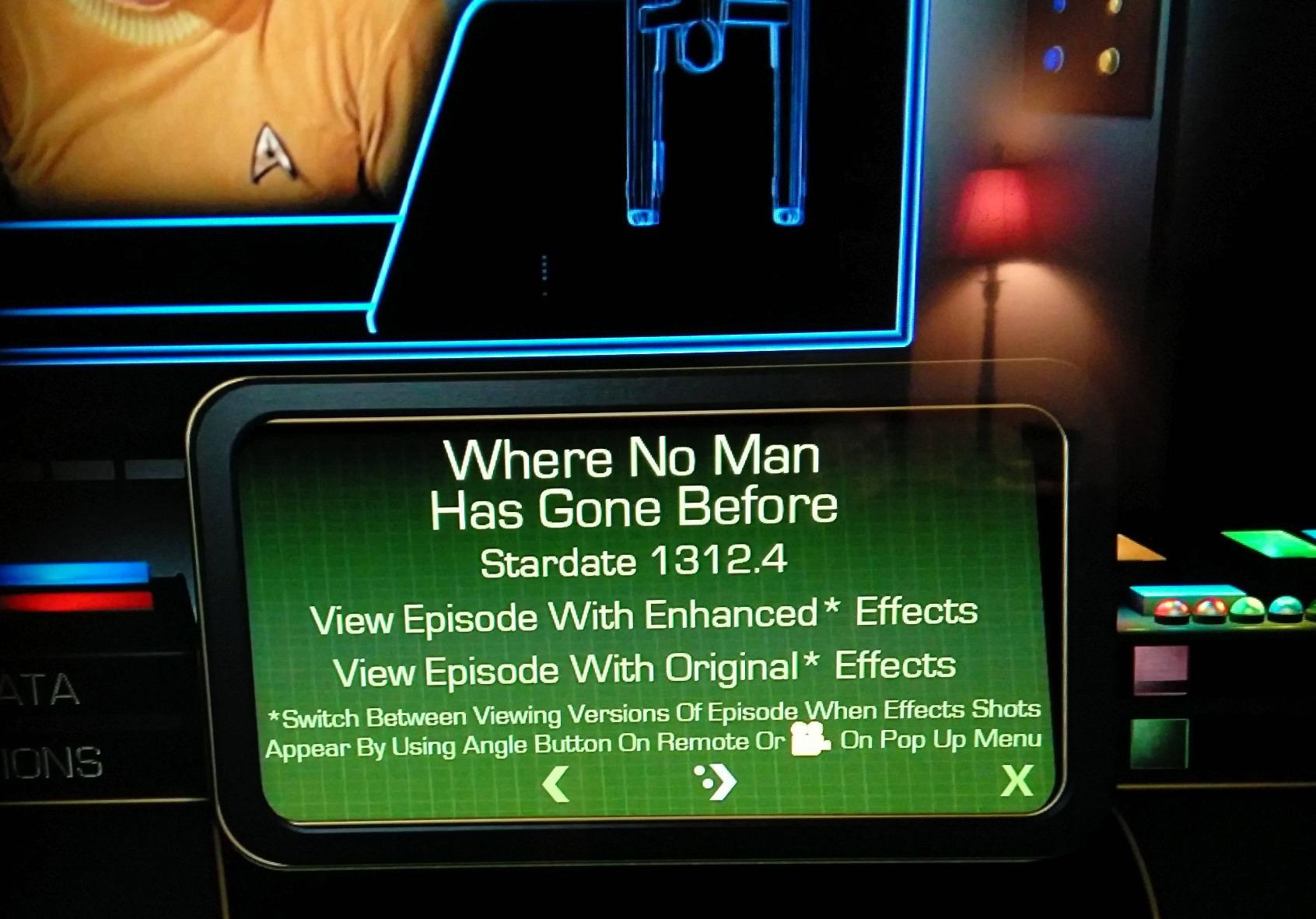
- Sort reviews by Top reviews Most recent Top reviews
Top reviews from the United States
There was a problem filtering reviews right now. please try again later..

Top reviews from other countries
- Amazon Newsletter
- About Amazon
- Accessibility
- Sustainability
- Press Center
- Investor Relations
- Amazon Devices
- Amazon Science
- Sell on Amazon
- Sell apps on Amazon
- Supply to Amazon
- Protect & Build Your Brand
- Become an Affiliate
- Become a Delivery Driver
- Start a Package Delivery Business
- Advertise Your Products
- Self-Publish with Us
- Become an Amazon Hub Partner
- › See More Ways to Make Money
- Amazon Visa
- Amazon Store Card
- Amazon Secured Card
- Amazon Business Card
- Shop with Points
- Credit Card Marketplace
- Reload Your Balance
- Amazon Currency Converter
- Your Account
- Your Orders
- Shipping Rates & Policies
- Amazon Prime
- Returns & Replacements
- Manage Your Content and Devices
- Recalls and Product Safety Alerts
- Registry & Gift List
- Conditions of Use
- Privacy Notice
- Consumer Health Data Privacy Disclosure
- Your Ads Privacy Choices

I Hope Star Trek's Forgotten Enterprise Captain Is Back For Good After Their Upcoming Movie Return
Rachel Garrett (Kacey Rohl) appears in Star Trek: Section 31 , and I hope her life before Star Trek: The Next Generation keeps being explored. Starring Academy Award winner Michelle Yeoh as Emperor Georgiou, Section 31 will take place during Star Trek's "lost era" of the early 24th century. Although the film's storyline remains unknown, it appears Georgiou will be recruiting team members for a top-secret Section 31 mission. Based on the teaser, Section 31 looks unlike any Trek that has been done before, and I'm excited to see where the story goes.
Star Trek: Section 31's new cast looks great. Michelle Yeoh is always phenomenal, of course, but Kacey Rohl's Rachel Garrett is especially interesting. Originally played by Tricia O'Neill, Captain Garrett was introduced in Star Trek: The Next Generation season 3, episode 15, "Yesterday's Enterprise," as the Captain of the USS Enterprise-C. Although Garrett only appears in a couple of scenes , Rachel holds the distinction of being the first woman to command the Enterprise and I have always wanted to learn more about her. Section 31's young Rachel Garrett already looks very different from the one we met on TNG, and I want to see the character's full journey.
Star Trek: Section 31 will flash back to Philippa Georgiou's childhood, revealing how she became the ruthless Mirror Universe Emperor.
Star Trek Should Tell More Stories About Enterprise Captain Rachel Garrett
Rachel garrett deserves to be the star of her own star trek story.
In only one Star Trek: The Next Generation episode, Captain Rachel Garrett made quite an impression. When the USS Enterprise-C emerges from a rift in spacetime, the USS Enterprise-D suddenly transforms into a battleship involved in a devastating war with the Klingons. Captain Jean-Luc Picard (Patrick Stewart) then has the unenviable task of informing Garrett of her doomed future , as history recorded the Enterprise-C as being destroyed. Even injured and grieving, Garrett realizes that something is off when she is brought to the Enterprise-D. When Captain Picard visits Garrett in sickbay, she questions him until he reveals that she and her ship have traveled 22 years into the future.

8 Most Unexpected Actors Cast In Modern Star Trek
Star Trek's current era on Paramount+ has lured several big-name and award-winning Hollywood actors to the franchise, many of whom raise eyebrows.
Garrett takes this revelation without even flinching, immediately worried about how her crew will take the news. I love the way this one scene paints Garret as a character. She comes across as an incredibly intelligent, skilled, and caring captain even on her worst day. I immediately wanted to know more about her, but Star Trek has revealed very little about Garrett onscreen. While Star Trek: Section 31 will hopefully answer some questions about the oft-forgotten Enterprise captain, I hope Star Trek continues to tell more stories about her beyond the Michelle Yeoh-led Section 31 movie .
Star Trek's "Lost Era" Is Full Of Fascinating Untold Stories
A future trek project could answer a lot of questions.
I want to see a future project dive fully into Star Trek's "lost era." Any series or film involving the USS Enterprise will find an audience, and I desperately want to see Captain Garrett in command of the Enterprise-C in all its glory. Whether in a full television series, a mini-series, or a series of films, Star Trek could get a lot of mileage out of stories from the early 24th century. For example, I would love to learn what happened to the USS Enterprise-B after Star Trek Generations, or maybe find out how the USS Bozeman got stuck in the time loop seen in Star Trek: The Next Generation's "Cause and Effect."
6 Star Trek Lost Era Questions Section 31 Movie Can Answer
Michelle Yeoh's upcoming Star Trek: Section 31 could provide answers to several lingering questions about Star Trek's lost era.
A story set during Star Trek's "lost era" could even check in on Picard during his command of the USS Stargazer. These are the kinds of projects I want to see as a Star Trek fan, ones that tell new stories, but fill in the gaps of established Star Trek canon. It's difficult to imagine a story flopping when it features a ship named Enterprise and a character as compelling as Rachel Garrett. I really hope Star Trek: Section 31 does well for many reasons, but partly because I want Kacey Rohl to stick around as Star Trek: The Next Generation's Rachel Garrett.
Key Background
- Star Trek: The Next Generation is set in the 24th century, nearly 100 years after the events of the original Star Trek series.
- The transporter effect was created by filming stirred glitter in water.
Star Trek: The Next Generation
Cast Michael Dorn, LeVar Burton, Brent Spiner, Wil Wheaton, Jonathan Frakes, Patrick Stewart, Marina Sirtis, Gates McFadden
Release Date September 28, 1987
Showrunner Jeri Taylor, Michael Piller, Rick Berman
Star Trek: Section 31
Director Olatunde Osunsanmi
Writers Craig Sweeney
Cast Humberly Gonzlez, Joe Pingue, Sam Richardson, Omari Hardwick, Robert Kazinsky, Michelle Yeoh, Kacey Rohl

Why Star Trek V: The Final Frontier Producer Blames William Shatner For The Film's Failure
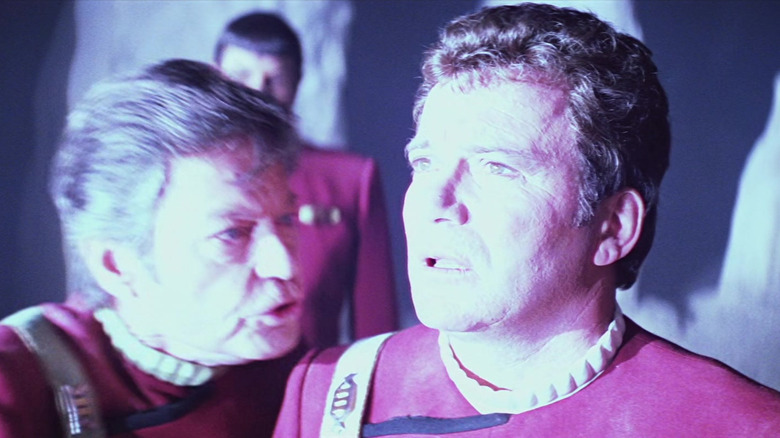
Going back to 1966, "Star Trek" co-stars William Shatner and Leonard Nimoy had what was called a "favored nations clause" in their contracts. The clause ensured that whenever one actor got a raise, or perhaps input into a script, the other one would get the same. This was done to comfort two actors who were constantly butting heads as to who the real "star" of "Star Trek" was. The favored nations clause made sure that neither actor could "pull ahead" of the other.
The clauses were still in place by the 1980s, so when Nimoy was hired to direct "Star Trek III: The Search for Spock" (1984) and "Star Trek IV: The Voyage Home" (1986) , Shatner was able to pull rank. Thanks to a pay dispute on "Star Trek IV," Shatner could contractually elbow his way into the director's chair for 1989's "Star Trek V: The Final Frontier." Not only that, but Shatner was also allowed to dictate story ideas and write treatments; Shatner has a story-by credit on "Frontier" as well. Patience, dear reader, as we shall describe the story in a moment.
Many will hasten to point out that "The Final Frontier" is often considered the worst of the extant 13 "Star Trek" movies. The script was clumsy, as it was constantly being re-written to placate the cast (the bulk of the film's $33 million budget went to talent). Moreover, the 1988 writers' strike cut into pre-production and Paramount couldn't afford its usual team of visual effects wizards from Industrial Light & Magic, forcing the studio to hire a cheaper technician on the fly. Constant budget cuts also made the film look cheap. There were myriad other production troubles besides.
According to a 1993 interview with Star Trek Explorer Magazine , "Frontier" producer Harve Bennett blames every problem directly on Shatner (who had final story approval). Bennett felt that Shatner's ultimate decision to make a "Star Trek" film about finding the physical location of God (!) was foolhardy. Shatner's decisions, Bennett argued, were bad from the start.
The story of Star Trek V
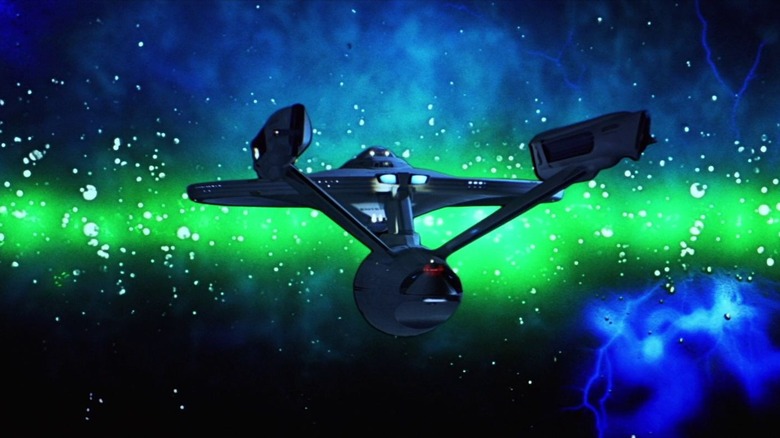
The story of "Star Trek V" is a little strange for the franchise. A hippie-like Vulcan cult leader named Sybok (Laurence Luckinbill) has the ability to psychically reach into the minds of his followers, erase their pain, and turn them into loyal followers. Sybok stages an elaborate scheme to lure the U.S.S. Enterprise to a certain planet where he will be able to hijack it and take it on a personal mission. Spock, we later learn, is unable to stand up to Sybok as he is Spock's half-brother.
And what was Sybok's personal mission? It seems he learned that the very center of the Milky Way galaxy is the physical home of the one true God. He aims to sail to the galactic core (in reality, a supermassive black hole) and speak to God in person. This contradicts "The Magicks of Megas-tu" (October 27, 1973), an episode of "Star Trek: The Animated Series," which depicted the Devil living at the center of the galaxy, but only deep-cut Trekkies are bothered by that. "Star Trek V" climaxes with Kirk, Sybok, and several others actually meeting God, or at least an alien claiming to be God.
To Bennett's eyes, this was a poor story from the jump. He was quoted as saying:
"I would say that 'Star Trek V' was the weakest of the pictures, both in terms of coherency and its box office, and [what] I would say without shirking responsibility is that the problem was Bill had story approval. [...] He knows this, so I'm not ratting on my friend, but basically, we got to a point where I said, 'Bill, we cannot make a movie about finding God!' I said that from the beginning."
Bennett also felt that there was no way "Star Trek" would actually introduce God as a character, so the search for the Divine, he felt, had an ending everyone could predict.
Kirk vs. God
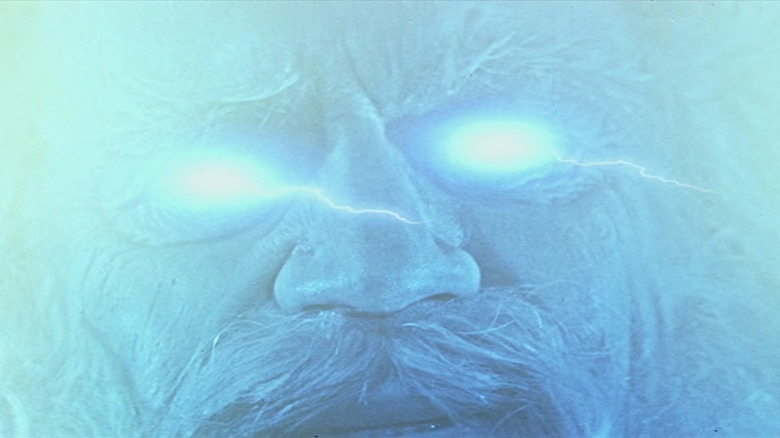
Bennett was succinct:
"I know that if you say in a TV logline, 'Tonight on 'Star Trek,' the crew of the U.S.S. Enterprise goes to find God,' everybody knows we're not going to go there. So as a storyteller, it gets to be a shaggy joke!"
It's worth stating that "Star Trek" takes place in a post-religious, wholly secular world where humans no longer appear to worship or believe in a God being. Show creator Gene Roddenberry was openly atheist and wanted "Star Trek" to rid itself of any notions of God. "Star Trek V" didn't start with a bad idea, thematically — a conflict between two men with very different views of infinity — but the actual physical search of God seemed silly and overblown to Bennett.
The producer also recalled Shatner's blood-minded insistence on the idea, though, stating he eventually had to wash his hands of the entire affair:
"He wanted to do it, so after much aggravation, I said, 'All right, we're going to go find God, but we're going to make it the best trip we possibly can!' [...] It was doomed by its premise. [...] I learned long ago, if it ain't in the premise, it ain't there, but Bill felt if we worked hard enough and dazzled them with enough stuff, we could do it, and I don't think we pulled that off [...] I think a faulty premise results in a flawed picture."
The premise was flawed and, unfortunately, there wasn't enough money on the table to dazzle audiences either. "Star Trek V" hasn't undergone any sort of fan re-litigation since its release in 1989, and it remains the worst of the "Star Trek" movies. Was it Shatner's fault? It's easy to point fingers in his direction. To his credit, Shatner has apologized .

- September 6, 2024 | First Wave From New Star Trek Starships Die Cast Collection Revealed; Pre-Orders Open Today
- September 6, 2024 | Podcast: All Access Star Trek And Robert Hewitt Wolfe Revisit The Sept. 2024 Bell Riots Of DS9’s “Past Tense”
- September 5, 2024 | Interview: Elias Toufexis Talks Breen Backstory And Not Playing L’ak As A Villain In ‘Star Trek: Discovery’
- September 5, 2024 | Data’s Evil Twin Turns Evil God In ‘Star Trek: Lore War’ Comics Crossover Event Coming In 2025
- September 4, 2024 | ‘Star Trek: The Motion Picture’ Getting A 45th Anniversary Steelbook 4K Blu-ray Release
Review: ‘The Art Of Glenn Hetrick’s Alchemy Studios’ Reveals The Makeup Magic Of ‘Star Trek: Discovery’

| September 4, 2024 | By: Dénes House 16 comments so far
Star Trek: The Art of Glenn Hetrick’s Alchemy Studios Written by Joe Nazzaro Published by Titan Books
“In the very beginning, one of the biggest challenges the Alchemy team had to deal with was that everything was to be built in their facility in Los Angeles but shot in Toronto. Shooting was more cost-efficient to do in Toronto due to tax rebates and available studio space, but despite the number of talented people there, that pool could be stretched thin at any given time by other productions going on simultaneously. ‘Therefore, it wasn’t just a question of how many people we needed there, insomuch as how often they were needed,’ explains Hetrick.”
What you expect from a big, glossy Star Trek art book is tons of glorious behind-the-scenes and on-set photographs of the amazing craft and artistry that goes into making your favorite science fiction franchise. And this impressive coffee table book has all that in spades. But what you don’t expect is a fascinating look into the logistics of actually producing the artwork at a scale and at a pace that is required for creating episodic television. And it’s gems like the quote above that, scattered throughout this volume, make this latest Trek art book from Titan as much fun to read as to look at.

Spread on Saru’s makeup (Titan Books)
Author Joe Nazzaro (who also wrote Star Trek Beyond: The Makeup Artistry of Joel Harlow ) takes us behind the scenes of the special makeup effects behind all five seasons of Star Trek: Discovery in this book, whose title is longer than the script of some Star Trek episodes, Star Trek: The Art of Glenn Hetrick’s Alchemy Studios: Revealing the Magic of Prosthetic Makeup. After a glowing foreword by Discovery executive producer and pirector Olatunde Osunsanmi, this tome walks, season by season, through more than sixty complex, detailed, and beautiful special effects makeup designs. Interspersed throughout the book are a handful of “Shop Talk” features, that explain the process of making silicon molds, prosthetic makeups, masks, and more. As the book unfolds, the reader gains a deep appreciation for the amazing talents of Glenn Hetrick and the members of his studio, but also for the gargantuan difficulties in producing makeup effects at feature film quality on a television schedule.
“Shop Talk” on silicone (Titan Books)
Throughout the run of Star Trek: Discovery , Hetrick and his crew have been nominated four times for Primetime Emmy Awards, winning twice, and nominated for the Hollywood Makeup and Hair Stylist Guild Awards twice, winning once. And the depth, quality, and creativity of their work shines through in this lavishly-illustrated book. Whether you loved or hated Discovery’s treatment of Klingons, in this book you can trace their development in season 1 in great detail, with deep dives into the various Klingon Houses, the influences behind their distinctive looks, and the rationale behind the decisions that were made. And then you can follow the changes that took place between season 1 and season 2.

Spread on Klingon “Torchbearer” (Titan Books)
I was intrigued by the chronicle of the design of the Orions in season 3. I had just thought they were people who had been painted green, but in interviews here, Hetrick explains why that wasn’t possible in a HDTV world. There are multi-page spreads covering the Klingon Torchbearer suit, the development of Saru and the Kelpiens, and the Talosians, among so many more. I especially liked the close-up looks the book offers at the designs for Discovery’s Yeoman Colt, the Lurians, Schlerm, the Betelgeusian, and the Efrosian. Hetrick discusses the thinking behind his redesigns of classic Trek alien species, and about the development of new aliens just for Discovery . There’s 12 pages about the creation of Species 10-C, called the “Gas Giants” in this book, which was not a makeup effect, but which Hetrick’s studio designed.

Spread on Orions (Titan Books)
Through it all, Hetrick’s passion for Star Trek, his intense creativity, and his hard-driving work ethic shine through clearly. If you love Star Trek art books, like I do, this one should have a treasured spot on your shelf. At least, whenever you can tear yourself away from poring over the huge, gorgeous photographs! And as you read the text, you’ll gain a deep appreciation for the massive amount of logistics and labor that goes in to producing just one slice of a high-definition science fiction show in the 2020’s.
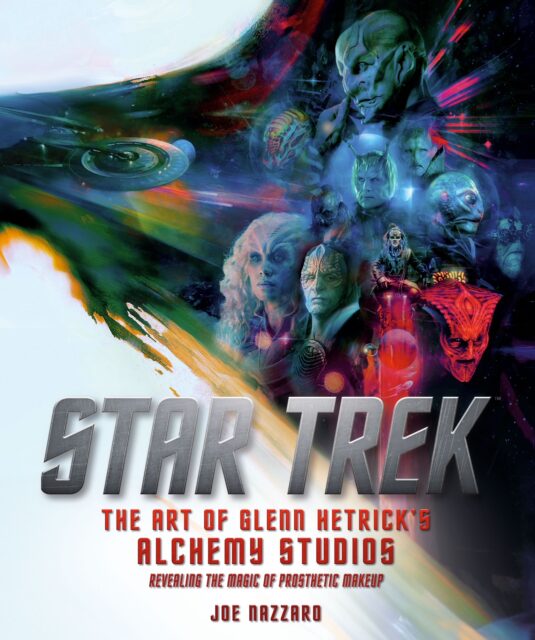
Cover for ‘Star Trek: The Art of Glenn Hetrick’s Alchemy Studios’
Available now
Star Trek: The Art of Glenn Hetrick’s Alchemy Studios was published by Titan Books on Tuesday, September 3rd. The hardcover is fully illustrated in color with 192 pages and is available now at at Amazon for $49.99 . Or save some money and support your local bookstore and order it from Bookshop.org for $46.49 .

Glenn Hetrick from Star Trek: The Art of Glenn Hetrick’s Alchemy Studios (Titan Books)
Find more news and reviews of Star Trek merchandise .
DISCLAIMER: We may link to product affiliate links that support TrekMovie by earning a small commission when you purchase through them.
Related Articles

Discovery , Interview
Interview: Elias Toufexis Talks Breen Backstory And Not Playing L’ak As A Villain In ‘Star Trek: Discovery’

Comics , Discovery , DS9 , Lower Decks , Strange New Worlds , TNG , TOS
See Things From The Tribbles Point Of View In Preview Of IDW’s Special ‘Star Trek #500’ Anthology

Discovery , DVD/Blu-ray/Streaming , Review
Review: ‘Star Trek: Discovery – The Final Season’ On Blu-ray Comes To A Satisfying Conclusion

Books , DS9 , Interview
Interview: Author Derek Tyler Attico On Exploring Star Trek’s Utopia In ‘The Autobiography Of Benjamin Sisko’
I really enjoyed the Joel Harlow book for Star Trek Beyond, but I’m sorry to say that I thought the alien makeup on Discovery was even worse than the writing.
I don’t generally voice this kind of complaint, but i t’s the very first thing that comes to mind when I think of the show.
I thought the makeup in and of itself was good, but not for the aliens they were supposed to be. I.e. the Klingon makeup was actually really well done, but they certainly didn’t look like Klingons! If it had been a brand new species or something it would’ve been great. In addition, there was definitely a more is better approach to the makeup. All of the traditional aliens had their makeup way overblown (Tellarites, Andorians, Ferengi, etc.) Again, I thought the makeup looked good, just not for the aliens they were portraying.
Totally Agree, 100% accurate. The final product made many fans upset. Even the chosen skin colors/tones edged into controversy. Was not only the Klingons, I did not enjoy very much the Orion, Andorian, and Ferengi updates.
As a long time Trekkie I love the makeup of the aliens in Discovery. I think has some of the best in all of Star Trek and that is a high platform to reach as there has been some fantastic alien makeup in past shows like in DS9.
For me as a Trekkie who grew up watching TNG/DS9 I find Discovery to be some of the best Trek made and not just in the makeup department it was some of the best writing/stories in the franchise.
Low threshold much?
‘Low threshold much?’ If you think the writing in DS9 is low threshold then I can’t imagine what you consider to be a high threshold my friend.
Discovery, the best writing and stories in the franchise? Well that’s certainly a take.
I said it has some of the best writing/stories in the franchise imo DS9 is still the better written show.
Discovery follows in a similar style of storytelling that which makes DS9 my number 1 favourite and imo the best Trek show made and Discovery to me is the 2nd best Trek show.
I’ve never been a huge fan of his designs. His updates are often over-designed (Discovery Ferengi are a good example, not to mention the S1 Klingons) and his philosophy on those updates – to “modernize” the look and reconceive from the ground up instead of using the classic makeup as a north star – was a colossal miscalculation of what fans (and casuals!) really wanted from Star Trek.
To be fair, his EXECUTION is phenomenal. Discovery helped pioneer a ton of great techniques for makeup application, and Hetrick really understood the need to update the application processes for the 21st century and how to embrace new technologies. The 3d printed latex for Saru, for instance, is brilliantly done and allows the actor to truly not get lost behind the makeup. As a technician and innovator he is truly peerless. It’s strange, considering how well Saru’s makeup allowed Doug Jones to convey beautiful subtle work, that his Klingon work was so cumbersome that the actors couldn’t even enunciate consonants and made all the Klingon sound muffled and gutteral.
I became familiar with Hetrick through his position as a judge on the show Face Off. No doubt he’s one of the best in the business. With Discovery, it was weird to see him frequently go against so many of the design philosophies he drilled into the heads of contestents. It was especially striking given how incredible some characters like Saru were. Gotta wonder what were his ideas vs him executing producer demands to the best of his ability.
It’s astounding that Hetrick’s makeup could be so bad after all those comments to wannabe artists on Face Off.
Why they didn’t keep the original design is baffling.
BUT. The artists couldn’t emote and they certainly couldn’t speak.
Absolutely unbelievably awful in every way.
So this is the guy to blame!
Not a fan of some of the updates (sometimes less is more) but they did amazing work.
As for the Klingon’s in season 1, the design was a reflection of whatever direction Bryan Fuller told them to take it in (this applies to the show’s overall production design as well).
Great team creating new aliens. I think Kelpiens and the Emerald Chain soldiers were my favorite aliens in Discovery…Kelpiens I think is due to Doug Jones, maybe.
How come the makeup from TNG to ENT looks so much better? From the Xindi to the Orions.
The stuff for DSC looks fake, actors struggling to emote and way over designed. Look again at DS9 and see how amazing Quark looks. And how an amazing actor like Rene Aubergenois can emote under prosthetics.
My favorite aliens from Discovery were the Kelpians and Saurians
Happy Star Trek Day: Paramount serves up free sample of TV shows to celebrate
Here's a rundown of this weekend's Star Trek Day 2024 fare to help launch the annual sci-fi party.
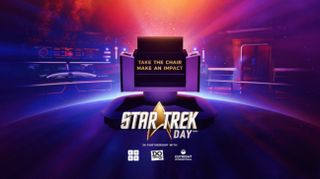
Happy Star Trek Day 2024!
It's that wonderful time of year again, when faithful Trekkies of all stripes proclaim their love of everything related to the expansive " Star Trek " sci-fi universe and honor the legacy of creator Gene Roddenberry's "Wagon Train To The Stars" that first launched on the NBC TV network back on Sept. 8, 1966.
This official day of celebration originated back in 2020, and the number of pop-up events, screenings, surprise announcements, contests, and fan gatherings continues to grow.

Watch Star Trek: Lower Decks on Paramount Plus: Get a one month free trial
Get all the Star Trek content you can possibly handle with this free trial of Paramount Plus. Watch new shows like Star Trek: Strange New Worlds and all the classic Trek movies and TV shows too. Plans start from $4.99/month after the trial ends.
Besides the older legacy films and broadcast TV series, these past seven years have seen a monumental surge of "Star Trek"-centric streaming offerings for fans to enjoy, including Paramount+'s " Star Trek: Discovery ," "Star Trek: Picard," "Star Trek: Lower Decks," "Star Trek: Strange New Worlds," "Star Trek: Prodigy," and the upcoming "Star Trek: Section 31" and " Starfleet Academy ."
Related: 'Star Trek:' History & effect on space technology
For this year's Star Trek Day, Paramount has announced "Take the Chair, Make an Impact," a worldwide campaign urging fans to embrace the optimistic vision of a sunnier future and to deliver back to the eclectic community of fans that "Star Trek" has cultivated over the decades.
As part of this celebration, "Star Trek" has partnered with a trio of global nonprofit organizations that reflect the core values of the franchise, including Code.org, which gives K-12 students the opportunity to learn computer science; DoSomething.org, which fuels young people to change the world; and Outright International, which advocates for LGBTIQ inclusion and equality globally.
Get the Space.com Newsletter
Breaking space news, the latest updates on rocket launches, skywatching events and more!
"Take the Chair" invites Trekkies to envision themselves in the classic U.S.S. Enterprise captain's chair and ask themselves, "What would I do if I were setting the course to the future?" Fans can engage with other enthusiasts via a digital experience available at StarTrek.com .
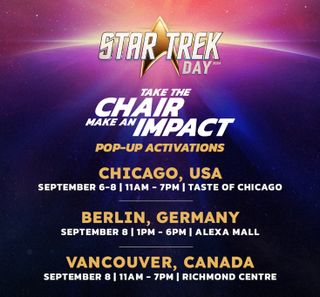
— Star Trek streaming guide: Where to watch the Star Trek movies and TV shows online
— 'Star Trek: Prodigy' is the 'Voyager' spin-off you never knew you wanted — and we love it
— Why 'Star Wars' needs its own answer to 'Star Trek: Lower Decks'
Paramount is also serving up an appetizing entertainment sampler platter for Star Trek Day, with the premiere episodes of many "Star Trek" series and "Short Treks" available to view for free from Sept. 7-13. The episodes can be tapped into on Paramount+'s partner platforms Amazon, Apple and Roku, its official YouTube page, Pluto TV and the Paramount+ free content hub (U.S. only).
Here's the complete lineup:
- "Star Trek: The Original Series," "The Cage"
- "Star Trek: The Next Generation," "Encounter at Farpoint, Part I & II"
- "Star Trek: Voyager," "Caretaker, Part I & II"
- "Star Trek: Deep Space Nine," "The Emissary, Part I & II"
- "Star Trek: Enterprise," "Broken Bow Part I & II"
- "Star Trek: The Animated Series," "Beyond the Farthest Star"
- "Star Trek: Strange New Worlds," "Strange New Worlds"
- "Star Trek: Lower Decks," "Second Contact"
- "Star Trek: Discovery," "The Vulcan Hello"
- "Star Trek: Picard," "Remembrance"
- "Star Trek: Short Treks" – "The Girl Who Made the Stars," "The Trouble with Edward," "Ask Not," "Runaway," and "Ephraim and Dot"
For more info on where to find "Star Trek" online, check out our streaming guide .
However and wherever you celebrate, a Happy Star Trek Day 2024 to all!
Join our Space Forums to keep talking space on the latest missions, night sky and more! And if you have a news tip, correction or comment, let us know at: [email protected].
Jeff Spry is an award-winning screenwriter and veteran freelance journalist covering TV, movies, video games, books, and comics. His work has appeared at SYFY Wire, Inverse, Collider, Bleeding Cool and elsewhere. Jeff lives in beautiful Bend, Oregon amid the ponderosa pines, classic muscle cars, a crypt of collector horror comics, and two loyal English Setters.
Watch eerie 1st teaser for Hulu's 'Alien: Earth' TV series (video)
'No Man's Sky' receives fishing, diving, and exo-skiffs via 'Aquarius' update (video)
China to test lunar-soil bricks in space to pave the way for its planned moon base
Most Popular
- 2 China's mysterious space plane returns to Earth after 268 days in orbit
- 3 NASA's solar sail spacecraft is visible in the night sky. Here's how to see it
- 4 BepiColombo probe captures stunning Mercury images in closest flyby yet
- 5 Watch Boeing’s Starliner head home to Earth without astronauts today
This Overlooked Character in Star Trek: The Next Generation Deserved Better

Your changes have been saved
Email is sent
Email has already been sent
Please verify your email address.
You’ve reached your account maximum for followed topics.
Quick Links
A polar opposite among others, chemistry, comedy, and a sweet spot for chocolate, lost potential or limitations that were previously set.
Star Trek has captivated multiple generations with brave new worlds and iconic characters who have secured a legacy that extends far beyond the stars. The launch of Star Trek: The Next Generation gave creator Gene Roddenberry a new vehicle for the social commentary he had developed in the original series. The second coming of the continuing voyages of the Enterprise portrayed hope for a future where diplomacy and exploration would be guided by technological wonders that took humanity to places they had never been.
Many of the different characters in Star Trek: The Next Generation embodied the traits of the original cast, as well as other notable figures from folklore. Captain Jean-Luc Picard was a modern incarnation of Captain Horatio Hornblower, and Data personified the razor-sharp logic of Mr. Spock. Proof that peace between adversaries could be accomplished took the form of Lt. Worf, a proud Klingon raised by human parents who continually seeks to uphold his people's traditions and maintain the decorum of a Starfleet officer.
One character who had the potential to be much more was the ship's counselor, Deanna Troi, portrayed by Marina Sertis. The emotional core of the crew, and often one who ended up as either a setup for comic relief or sexual tension, there was much more that could have been done with Deanna Troi as a character.
Female characters on Star Trek have continually been examples of independent thinkers and strong-willed personalities. In the original series, Lt. Uhura broke down barriers and provided thoughtful insight. Nurse Chapel was a welcome opposite to the eccentric and short-tempered Dr. McCoy. Even in Star Trek: The Next Generation , there were female characters who carried on unique roles in various capacities. Fans of the early seasons will remember Tasha Yarr, the headstrong security officer, and Dr. Pulaski, who, along with Dr. Crusher, served as beacons of morality and intellectual prowess in healing the sick and caring for others.
Deanna Troi possessed many qualities that made her an interesting character and a strong asset to the crew on the bridge. As an empath who could sense strong feelings in others, she played a pivotal role in the fragile diplomacy that existed between the other civilizations that came into contact with the Enterprise . Still, in a show that was known for its complex characters and stories that probed emotional depth, Deanna Troi sometimes felt underutilized. The insightful nature and guidance that could have been deeply established in Deanna Troi was often displayed through Guinan, portrayed by Whoopi Goldberg. Even in Star Trek: First Contact , the most memorable scene involving Deanna Troi was her sitting at a bar suffering the effects of too much tequila.
10 Sci-Fi Shows Like Star Trek That Aren’t Star Trek
A bunch of other sci-fi series have carried on Star Trek's legacy of world-building and proven that it's left plenty of room behind for exploration.
There were certainly a lot of moments when Troi proved to be an invaluable member of the crew and an exemplary part of solving the complex situations that the Enterprise would find itself in. Despite these attributes, many of the moments that even the most avid fans of the show remember involve her irrepressible mother, Lwaxana Troi , the sexual tension that she had with various members of the crew, and an obsession with chocolate.
Lwaxana Troi, played by Majer Barret, who had portrayed Nurse Chapel in the original series and provided the voice for the computer in both incarnations of the show, was, for the lack of a better term, the comic relief in the episodes in which she appeared. Constantly pursuing Picard and being the epitome of every overbearing and embarrassing parent, Lwaxana Troi was on par with Q as the series' most memorable and recurring character. Deanna Troi would often be the incidental character to set up these comedic moments with her mother . The sexual tension that involved Deanna Troi impacted multiple characters, such as Riker and Worf, and the most comedic of these appeared in an episode where Lt. Barclay imagined Troi, in a recurring holodeck fantasy, as the "goddess of empathy."
That's not to say that these moments ruined Troi as a character at all. Far from that. If anything, these moments certainly made Troi a memorable part of the crew. When aspects of romantic chemistry, dessert, and a boisterous parent overshadow the qualities that make someone an invaluable asset, especially when compared to so many other iconic characters who have flushed-out development and complex backstories known to serious and casual fans alike, it feels like there's so much more that could have been accomplished .
Star Trek: Deanna Troi’s 16 Best Quotes from the Franchise
The beloved half-Betazoid character is empathic, willful, playful, sarcastic, and wears her heart on her sleeve. Here are Deanna Troi's best quotes.
Star Trek: The Next Generation
Not available
The question that should be asked is whether Troi could have been developed further or whether the character's pre-existing limitations hindered said development. It's difficult to say. On one hand, there were multiple occurrences where Deanna Troi played a critical role in dealing with the complex emotions of the crew, particularly in the relationship between Worf and his son Alexander and the child of a recently deceased crew member. The capacity to heal and strengthen emotional bonds among so many different personalities isn't just something that's essential for a television series, but the human experience as well.
Deanna Troi played a pivotal role in the series, but the negative aspects that became associated with her as a character hindered not only her development but the perception among casual and avid viewers of Star Trek: The Next Generation . Considering how female characters were presented in later series, such as Deep Space Nine and Voyager , it appears that there's much more that could have been accomplished with Deanna Troi.
share this!
September 4, 2024
This article has been reviewed according to Science X's editorial process and policies . Editors have highlighted the following attributes while ensuring the content's credibility:
fact-checked
trusted source
written by researcher(s)
How gravitational waves could help detect Star Trek-style warp drive spaceships
by Katy Clough, Sebastian Khan, Tim Dietrich, The Conversation

How much do we really know about what else is out there in the universe?
Let's take an outlandish example. If there were aliens flying around our galaxy with the sort of warp drive technology we often see in sci-fi shows, what would the signal from their ships look like? Perhaps, surprisingly, our research shows we have the tools to answer this question, regardless of whether such things really exist.
Telescopes that use light to probe space can now see almost to the edge of what is observable. Each new frequency we have explored—from gamma rays and X-rays, to infrared and radio—has taught us something new and unexpected.
In 2015, a new kind of telescope, a detector called Ligo , was turned on, not looking for light waves but for gravitational waves , which are invisible "ripples" in space and time. Again nature surprised us with a signal labeled GW150914 from a pair of black holes. Each were about thirty times the mass of our sun, merging together in a violent collision 1.4 billion light years away.
Since then gravitational waves have become an essential new tool for scholars exploring the universe. But we are still at the very beginning of our explorations. What signals might we see in the data, and will they change how we see the physics of the cosmos?
There is, however, a more practical question that often gets overlooked—if something is out there, how would we recognize it?
From sci-fi to serious science
You may have seen warp drives in series like Star Trek . A warp drive is a hypothetical form of technology that compresses the space in front of a starship and expands it behind. While nothing can travel faster than the speed of light, in a warp drive we can cheat by making our distance shorter. So, the time it takes to go from A to B is less than the time light takes on another uncompressed path.
The jump from sci-fi to real science was made by theoretical physicist Miguel Alcubierre in 1994, when he was inspired to model a warp drive using Einstein's equations of general relativity .
General relativity is a relationship between spacetime curvature (gravity) and a distribution of matter or energy (stuff). Typically, we start by knowing the "stuff." For example, we know that we have a blob of matter that represents a planet or star. We then put that stuff into the equations to determine how the spacetime curves. And how it curves tells us the gravity we would measure around the object.
You could say that this is exactly what Isaac Newton's picture of gravity does—giving a relation between an object's mass and the gravitational force it exerts. And you would be right. But the concept of spacetime curvature gives rise to a much richer range of phenomena than a simple force. It allows a kind of repulsive gravity that drives our universe to expand, creates time dilation around massive objects and gravitational waves in spacetime and—in theory at least—it makes warp drives possible.
Alcubierre tackled his problem from the opposite direction to the usual one. He knew what kind of spacetime curvature he wanted. It was one in which an object could surf on a region of warped spacetime. So, he worked backwards to determine the kind of matter configuration you would need to create this. It wasn't a natural solution of the equations, but rather something "made to order." It wasn't exactly what he would have ordered though. He found he needed exotic matter , something with a negative energy density, to warp space in the right way.
Exotic matter solutions are generally viewed with skepticism by physicists, and rightly so. While mathematically, one can describe material with negative energies, almost everything we know appears to have a positive energy. But in quantum physics , we have observed that small, temporary violations of energy positivity can occur, and so, "no negative energy" can't be an absolute, fundamental law.
From warp drives to waves
Given Alcubierre's model of the warp drive spacetime, we can begin to answer our original question—what would a signal from it look like?
One of the cornerstones of modern gravitational wave observations, and one of its greatest achievements, is the ability to accurately predict waveforms from physical scenarios using a tool called "numerical relativity" .
This tool is important for two reasons. First, because the data we get from detectors is still very noisy, which means we often have to know roughly what a signal looks like to be able to pull it out of the datastream. And second, even if a signal is so loud that it stands out above the noise, we need a model in order to interpret it. That is, we need to have modeled many different types of event, so we can match the signal to its type; otherwise we might be tempted to dismiss it as noise, or mislabel it as a black hole merger.
One problem with the warp drive spacetime is that it doesn't naturally give gravitational waves unless it starts or stops. Our idea was to study what would happen when a warp drive stopped, particularly in the case of something going wrong. Suppose the warp drive containment field collapsed (a staple storyline in sci-fi); presumably there would be an explosive release of both the exotic matter and gravitational waves. This is something we can, and did, simulate using numerical relativity.
What we found was that the collapse of the warp drive bubble is indeed an extremely violent event. The enormous amount of energy needed to warp spacetime gets released as both gravitational waves and waves of positive and negative matter energy. Unfortunately, it's most likely the end of the line for the ship's crew who would be torn apart by tidal forces.
We knew a gravitational wave signal would be emitted; any movement of matter in a messy way creates such a wave. But we couldn't predict the amplitude and frequency, and how these would depend on the size of the warped region.
We were surprised to find that for a 1km sized ship, the amplitude of the signal would be significant for any such event within our galaxy and even beyond. At a distance of 1 megaparsec (slightly further than the Andromeda galaxy), the signal is similar to our current detector sensitivity. However, the frequency of the waves is about a thousand times higher than the range they are looking at.
We should be honest and say that we can't claim our signal as the definitive warp drive signal. We had to make quite a few specific choices in our model. And our hypothetical aliens may have made different ones. But as a proof of principle, it shows that cases beyond standard astrophysical events can be modeled, and may have distinctive forms and shapes that we can search for in future detectors.
Our work also reminds us that compared to the study of light waves, we are still at the stage of Galileo, taking pictures of the universe in the narrow frequency band of visible light. We have a whole spectrum of gravitational wave frequencies still to explore, which will be sensitive to a range of phenomena happening across space and time.
Provided by The Conversation
Explore further
Feedback to editors

Massive merger: Study reveals evidence for origin of supermassive black hole at galaxy's center
9 hours ago

Neolithic bones reveal isolated Yersinia pestis infections, not pandemics

New quantum error correction method uses 'many-hypercube codes' while exhibiting beautiful geometry

Solving the side effect problem of siRNA drugs for genetic disease treatment

Researchers advance new class of quantum critical metal that could advance electronic devices
10 hours ago

Protecting just 0.7% of world's land could help save a third of unique and endangered species
11 hours ago

Crystallized alternative DNA structure sheds light on insulin and diabetes

Researchers propose mechanistic framework to explain complex microbe-host symbioses

Low-cost nanomaterial technology can detect cancer genes with ultra-high sensitivity

Scientists uncover mechanism preserving centromere during cell division
Relevant physicsforums posts, how does output voltage of an electric guitar work, looking for info on old, unlabeled geissler tubes, brownian motions and quantifying randomness in physical systems.
Sep 2, 2024
Container in an MRI room
Sep 1, 2024
Hysteresis of a Compressed Solid
Aug 30, 2024
Besides magnetic monopoles, what else doesn’t exist?
More from Other Physics Topics
Related Stories

New study simulates gravitational waves from failing warp drive
Jul 29, 2024

Warp drives could generate gravitational waves
Jun 17, 2024

What if you flew your warp drive spaceship into a black hole?
Aug 29, 2024

Model suggests subluminal warp drives may be possible
May 14, 2024

Gravitational waves and the geometry of spacetime
Jun 4, 2024

Warp drives: Physicists give chances of faster-than-light space travel a boost
Apr 26, 2021
Recommended for you

Researchers make sound waves travel in one direction only, with implications for electromagnetic wave technology
12 hours ago

Why are black holes stable against their own gravity?
13 hours ago

First detection of cross-correlation between cosmic shear and X-ray background enhances baryonic matter understanding
Sep 5, 2024

Major leap for nuclear clock paves way for ultraprecise timekeeping
Sep 4, 2024

Bridging quantum mechanics and cosmology: The role of the generalized uncertainty principle

Supercomputer simulations provide new insights into calcium-48's controversial nuclear magnetic excitation
Sep 3, 2024
Let us know if there is a problem with our content
Use this form if you have come across a typo, inaccuracy or would like to send an edit request for the content on this page. For general inquiries, please use our contact form . For general feedback, use the public comments section below (please adhere to guidelines ).
Please select the most appropriate category to facilitate processing of your request
Thank you for taking time to provide your feedback to the editors.
Your feedback is important to us. However, we do not guarantee individual replies due to the high volume of messages.
E-mail the story
Your email address is used only to let the recipient know who sent the email. Neither your address nor the recipient's address will be used for any other purpose. The information you enter will appear in your e-mail message and is not retained by Phys.org in any form.
Newsletter sign up
Get weekly and/or daily updates delivered to your inbox. You can unsubscribe at any time and we'll never share your details to third parties.
More information Privacy policy
Donate and enjoy an ad-free experience
We keep our content available to everyone. Consider supporting Science X's mission by getting a premium account.
E-mail newsletter

IMAGES
VIDEO
COMMENTS
Star Trek (8.4/10) is an American science fiction media franchise created by Gene Roddenberry, which began with the eponymous 1960s television series and became a worldwide pop-culture phenomenon. Since its creation, the franchise has expanded into various films, television series, video games, novels, and comic books, and it has become one of ...
ASC Staff. At the eyepiece, Linwood G. Dunn, ASC sets a shot while at work on with the Enterprise and Botnay Bay models at Film Effects of Hollywood while shooting the episode "Space Seed" in 1966. The first entry in our 12-part retrospective series documenting 50 years of production and post on the Star Trek franchise.
The effects in Star Trek: The Original Series were no different, but the sheer number of shots made for the show, and the need for them to be of "film quality," required some neat innovation.
10 years ago, the 40th Anniversary of Star Trek was fast approaching. HDTV was the future. CBS knew they needed to do something to be sure the "one that started it all", The Original Series ...
When Star Trek: The Original Series debuted in 1966 on television, viewers saw innovative visual effects they had never seen before. However, 60 years later, CBS decided to remaster the series for re-release on home video and syndication. Whether it's nostalgia or the continued advancement of VFX, the original effects created for the Star Trek series are simply better.
The reboot of the Star Trek franchise with the 2009 film directed by J.J. Abrams introduced a new era of visual effects, blending practical effects with state-of-the-art CGI to create a visually stunning and action-packed cinematic experience. The use of cutting-edge technology and innovative design brought a fresh aesthetic to the franchise ...
Star Trek has used a variety of state-of-the-art visual effects over the years, from the original series to modern movies and TV. Let's take a closer look.
Star Trek is an American science fiction television series created by Gene Roddenberry that follows the adventures of the starship USS Enterprise (NCC-1701) and its crew. It acquired the retronym of Star Trek: The Original Series (TOS) to distinguish the show within the media franchise that it began. [3]The show is set in the Milky Way galaxy, c. 2266-2269.
Original Star Trek Gets Upgraded ... is digitally remastering all 79 episodes of the original series to enhance the show's 1960s-era visual effects with 21st-century computer-generated graphics ...
The transporter is great narrative tool to keep writers from having to spend time landing their starship or dispatching a shuttle to a planet week to week, but I'm with Doctor McCoy in believing ...
Douglas Grindstaff at the Moviola, working on Star Trek in 1967, from a news paper article. Photo courtesy of Douglas Grindstaff. Working with small TV budgets, Grindstaff maximized what he had. For example, to create the shimmering, musical sound of the Enterprise transporter, he blended together a few musical effects and electric generator ...
Some of these effects are among the most memorable ever created for the medium that FCC chief Newton Minow once famously referred to as "a vast wasteland." Back in 1966, Doug Grindstaff, sound mixer for the original Star Trek series, didn't realize at the time he was making TV history. In fact, he didn't even have a parking pass on the ...
Very few programs in television history can be easily identified by their sound effects alone. The original 1966-69 run of Gene Roddenberry's Star Trek belongs in that select fraternity, thanks ...
In 2006, a Remastered version of Star Trek: The Original Series was attempted. Beyond simply moving the show into an HD screen format, every special effect shot in the series was replaced with computer generated ones. Now, if you try to watch this series on Netflix, these "modernized" versions are the only things being offered.
"Star Trek: The Original Series" Digitally remastered for HD, with new theme music and all new CGI special effects: Availability: Broadcast Syndication (2006-2009) [see channel list]DVD and ...
For the first time ever, explore archival material created by legendary Star Trek collaborators, including Robert Abel, Syd Mead, Ralph McQuarrie, Andrew Probert, and Ken Adams. Star Trek: The Motion Picture - Inside the Art and Visual Effects will explore the film that began the critically acclaimed blockbuster film series. Showcasing ...
An Adobe After Effects tutorial. After finding out that the DVDs for Star Trek: The Next Generation included an extra where the elements used to make up the iconic transporter look were shown, I decided to see if I could recreate them within After Effects. The original footage in the extra is not
Star Trek: The Original Series TOS Intro New Visual Effects
Name Last modified Size; Go to parent directory: Star Trek - 3x01 - Spectre of the Gun.avi: 22-Dec-2021 07:17: 350.3M: Star Trek - 3x01 - Spectre of the Gun.mp4
Originally released in 1979, Star Trek: The Motion Picture became the fourth highest grossing movie of the year and earned three Academy Award nominations for Best Visual Effects, Best Art Direction, and Best Music, Original Score. The film successfully launched the Star Trek franchise beyond the original television series, despite having been rushed to theaters with incomplete special effects ...
The current blu-ray version of this set (as I write this in early 2017) is pretty much the definitive set (to date) for die-hard Trekkies. Every episode of the original series is here with the option to watch with either the new "enhanced" special effects *or* the original "unadulterated" special effects.
Star Trek: The Next Generation is set in the 24th century, nearly 100 years after the events of the original Star Trek series. The transporter effect was created by filming stirred glitter in ...
The story of "Star Trek V" is a little strange for the franchise. A hippie-like Vulcan cult leader named Sybok (Laurence Luckinbill) has the ability to psychically reach into the minds of his ...
Author Joe Nazzaro (who also wrote Star Trek Beyond: The Makeup Artistry of Joel Harlow) takes us behind the scenes of the special makeup effects behind all five seasons of Star Trek: Discovery in ...
For this year's Star Trek Day, Paramount has announced "Take the Chair, Make an Impact," a worldwide campaign urging fans to embrace the optimistic vision of a sunnier future and to deliver back ...
Even in Star Trek: First Contact, the most memorable scene involving Deanna Troi was her sitting at a bar suffering the effects of too much tequila. Related 10 Sci-Fi Shows Like Star Trek That ...
Read the original article. Citation: How gravitational waves could help detect Star Trek-style warp drive spaceships (2024, September 4) ...